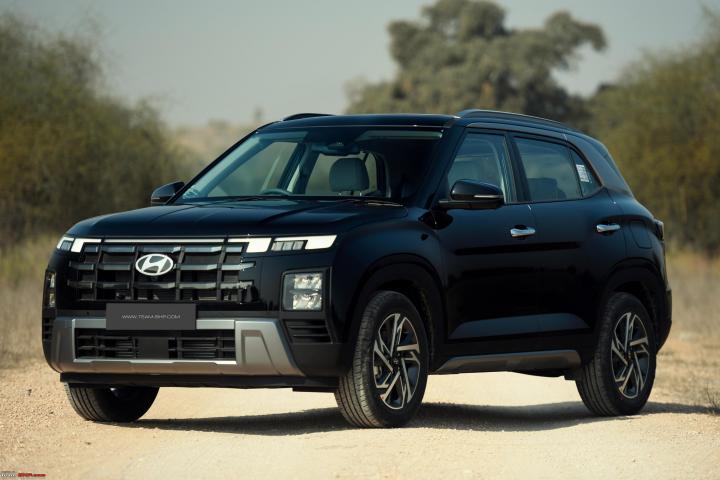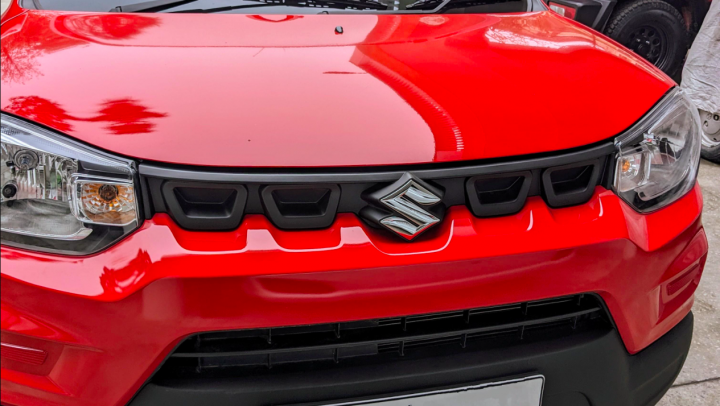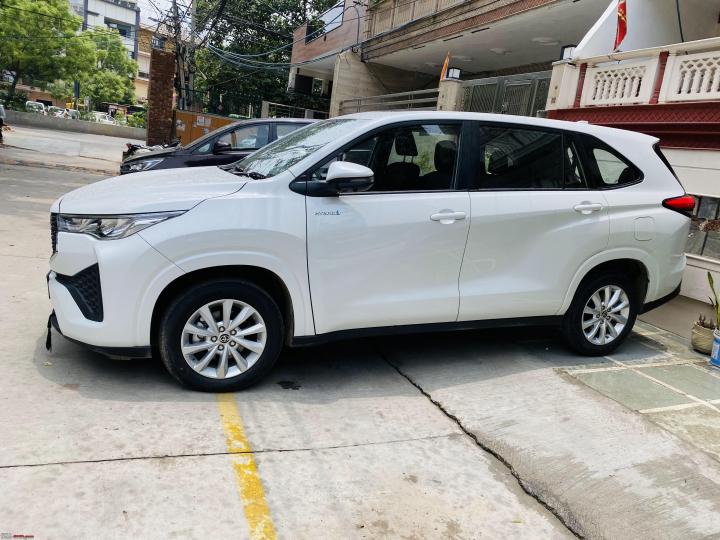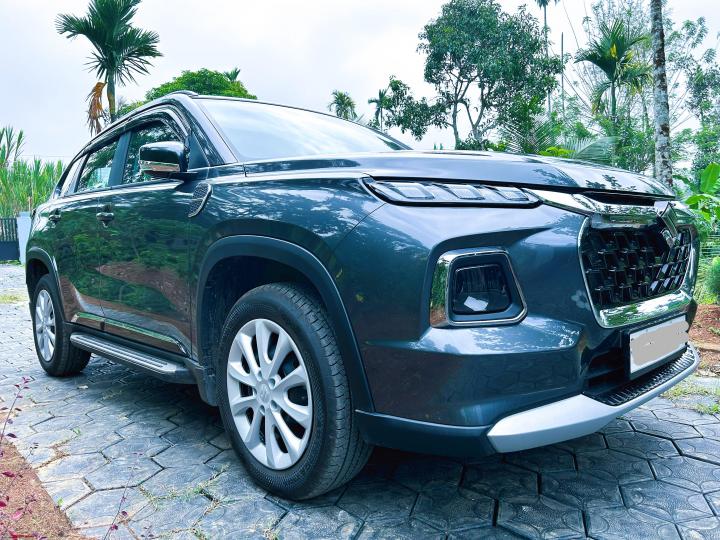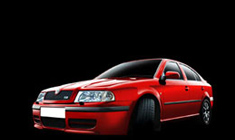News
Test drove multiple variants of the Kia Carens: Booked the petrol DCT
Found the iMT as a nifty solution if you want the fun of driving a manual but don't want the hassle of pressing the clutch.
BHPian nightfury95 recently shared this with other enthusiasts.
I went for a test drive today. Got in touch with my Kia dealer earlier last week and requested to test drive two models of the Carens and they arranged all the cars promptly for my convenient date at the dealership. They did offer to bring the car home but said could only get one vehicle at a time and I didn't want to create a big hassle for either doing it for multiple days so I asked if they could just have the vehicles ready at the showroom and the salesperson I am dealing with made sure all the variants were available at the said time. I test-drove the Diesel AMT, Petrol iMT and Petrol DCT (it was a last-minute choice).
I ended up test-driving all three models along with my dad who took turns mid-way. We had another two of our family members along with the salesperson so the car was almost fully loaded which gave a good real-world use scenario for my case. I finalised my booking for the DCT variant.
A little ironic since I said DCT was out of the picture but I was surprised too after my final decision. Why?
The model I drove first was the iMT petrol variant. Found it as a nifty solution if you want the fun of driving a manual but don't want the hassle of pressing the clutch. It was easy to get used to from the get-go after figuring out the sensitive brake pedal and the little delay in power delivery after pressing the accelerator. I was sold on the variant but waited to make a decision.
Second was the 1.5 Diesel Auto. Coming right after driving the petrol, first thing I noticed was the lack of power but it does get going once the turbo kicks in and the torque felt healthy but was nowhere near as nippy and responsive as the petrol. Surely does struggle to get going initially with the car full and not the best option if the car is going to be full. The engine did feel very refined and the cabin felt quite silent. Long-term thoughts about changing regulations and fuel prices becoming similar plus the car won't be used too frequently made me drop the diesel option right away.
Finally, got to drive the Petrol DCT variant. My friend suggested me to try the DCT too since the previous three days I spent driving my friend's Seltos 1.4 Turbo petrol DCT while attending a wedding in Bangalore giving a little heads up on what to look out for and comparing the new 1.5 powertrain in the Carens. With the recent experience, I set out for the test drive and the getaway felt smooth and just normal like a torque converter automatic, unlike the slightly jerky getaway I felt with my friend's Seltos. I chatted with the salesperson while driving and he was quite honest saying the older DCT from the 1.4 was not refined at lower speeds and had a few issues but this is not the case with the ones in the 1.5 variants. He also told me I could do a more brief test drive to see how I felt with a few more minutes in the car so I took a little longer route with few signals, a little highway distance and the moderate Chennai traffic gave it a bit of test and I did feel the difference, the gear shifts felt seamless all the way and even at lower speeds which are DCTs vain(the Carens tuning seems to be on the gentle side rather than sporty). Swapped mid-way with my Dad taking over the wheels to drive back to the dealership and within a few minutes he said "This doesn't feel like the horrible VW you had" which was bitter but also honest words and he liked the convenience of the automatic and not wanting to still shift without a clutch so this sold me on the DCT variant. Dad is going to be using it the majority of the time so his thoughts were the priority.
Coming to DCT concerns, even though decided I did think for a while before making the final booking:
The ownership experience with my VW Golf GTI was quite a mess. I replaced two gearboxes under warranty within the first 10000km and I don't never pushed the car to its max. The initial one failed due to electrical issues while it was parked and the second one due to overheating while on the highway and my Dad was driving it so it sums up his feelings about my VW. The third one lasted without issues till I sold after a year of ownership but was jerky and did have transmission fluid cooling issues which got corrected by an aftermarket part and a small remapping.
I drove my friend's Seltos initially when it was kind of new and drove again after two years again this time which was already at 6 digit odometer reading. He said he learned to live with the initial jerks but hasn't experienced overheating issues after the couple of initial ones and mentioned very heavy traffic may be an issue which won't be a problem for me since I live in the outskirts of the city and won't be experiencing a lot of traffic daily. Seeing the car that has held up well over the last four years, did give me a bit of a relief it was quite reliable. So it did make my decision easier, while the iMT felt good but the automatic just felt more convenient considering the idea of clutch is not present in both cases. Slotting the gear into N or P in an automatic gearbox during a long halt is always a good practice whether is a TC or DCT. The torque converter is still better and more reliable for day-to-day use but it here had to go for the option available. Like you said Vivek, only time will tell.
Ended up booking the Luxury Plus 7 1.5 T-GDI DCT variant and got a promised delivery window between March 3rd and 4th week. Now got to wait for the car.
A very good observation, Carens is really spacious for a small-looking car from the outside and even the third row felt comfortable for a tall adult.
Check out BHPian comments for more insights and information.
- Tags:
- Indian
- Kia Carens
- MPV
- Petrol
- Diesel
News
2024 Hyundai Creta: BHPians share their choice of engine & gearbox
What’s working in the favour of the Hyundai Creta is that it has a host of powertrains on offer.
We had recently done a poll on the Hyundai Creta facelift and its competitors like the Kia Seltos, Honda Elevate, Volkswagen Taigun and more. The Korean twins gathered almost 55% of the total votes which goes on to show how successful both the cars have been. In the 2024 facelift, Hyundai has brought the Creta up to speed with the competitors and then some. There are some areas where the Creta still lags behind, but then those aren’t really major deal-breakers.
What’s working in the favour of the Hyundai Creta is that it has a host of powertrains on offer. There's a 1.5-litre naturally aspirated petrol engine that’s available with a 6-speed manual transmission and a CVT automatic transmission, a new 1.5-litre turbo-petrol engine that’s available with a 7-speed dual clutch transmission (Kia Seltos also offers the same with an iMT) and a 1.5-litre diesel engine with a 6-speed manual transmission or a 6-speed torque converter automatic.
So if were to buy a Hyundai Creta in 2024, which engine and gearbox combination would you pick & why?

The 1.5-litre NA petrol engine is the perfect choice for a sedate driver who enjoys a smooth driving experience. The engine is refined, smooth and has enough punch to get around the city and on the highways as well. It’s offered with a 6-speed manual and a CVT automatic. An advantage of this powertrain over the Kia Seltos is that in the Creta, you can have the 1.5- litre NA petrol in the top variant with both manual and CVT options.
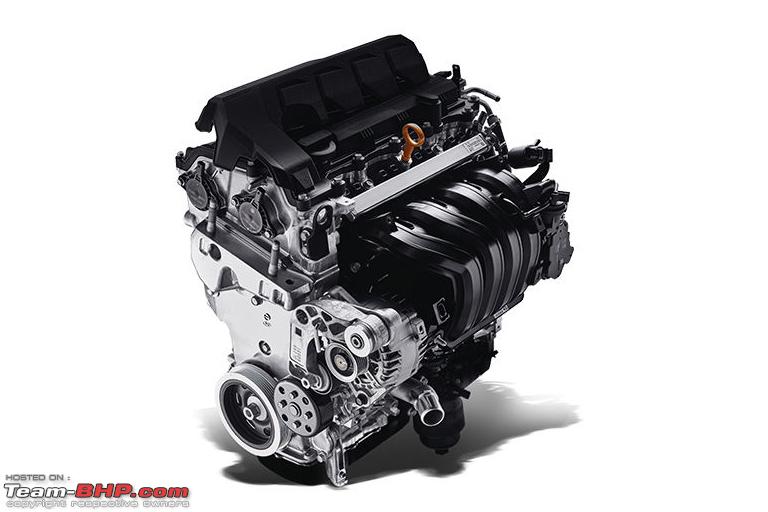
Then you have the much-awaited 1.5-litre turbo petrol engine that replaces the older 1.4-litre turbo petrol engine. This is one of the most powerful engines in the segment and is shared with the Kia Seltos. Unlike in the Seltos though, this engine is available only with a 7-speed dual-clutch automatic transmission that to only on the top SX(O) variant. Read our detailed drive report here.

For diesel lovers, there’s a 1.5-litre unit that can be had with a 6-speed MT or a 6-speed AT. Note that the Kia Seltos offers a clutchless MT (iMT) with this diesel engine and not a conventional 6-speed MT like Hyundai. This diesel engine from Hyundai-Kia is refined and has enough grunt to keep you engaged over long distances. You can read our drive report here.

Here's what GTO had to say on the matter:
158 BHP in an everyday crossover is enough to convince me! My pick will be the 1.5L Turbo DCT for its fast, effortless performance on the open road. The Diesel AT is also brilliant, but my running isn't high enough to justify it. Each one of my cars averages 5000 km / year.
Here's what BHPian vattyboy had to say on the matter:
Want to share my experience with people who are considering Creta Diesel.
I bought Creta Diesel AT last month.
My Jeep Compass 2.0 D Manual FE >= Creta 1.5 Diesel AT FE.
Creta's 6-speed AT is tuned to keep the engine rpm above 1500 all the time, the moment it goes below 1500 rpm the gearbox tends to downshift, which results in slightly less FE.
For example in the city-
At 35-40 kmph compass can be driven in 4 gear at 1200 rpm, but at this speed, Creta AT will keep the engine in 3rd gear at 1650 RPM. Which results in the same mileage for both cars.
So people who are considering Creta Diesel due to only 1 reason i.e. Mileage then they should buy Manual.
Advantage of Diesel AT-
- Brisk performance, Point and Shoot. As the gearbox keeps the engine above 1500 rpm the engine is always in its turbo band to satisfy the enthusiast in you.
- I am getting 19 kmpl on the highway when I am so so so forgiving on the throttle and I think turbo petrol can give 17 with the same style.
- So I think 2 kmpl is worth sacrificing for that extra power.
So I voted for 1.5 Turbo Petrol.
Here's what BHPian fhdowntheline had to say on the matter:
As a past owner of the Creta 1.5 Diesel AT and present owner of the Verna turbo DCT, I would recommend without any hesitation to go for the turbo petrol. While the diesel-AT combination is creamy smooth and historically more reliable, it is after all, a diesel. The turbo petrol is more refined across the rev-range, and it (at least on the Verna) delivers a wallop after 1600 rpm or so. The quick shifting DCT also helps here, and there is definitely a greater ease of overtaking than the diesel AT , which is not bad by itself.
As far as long distance cruising goes, my observation is that the diesel AT provides a slightly more even torque spread, allowing you to cruise between 80-110 kph in a more relaxed manner. The Verna turbo sometimes feels like it is getting bored when cruising, especially under light load , and seems a tad eager to sprint forth at a slight dab of the throttle. And in Sport mode, it is mildly insane.
Here's what BHPian Chanda_Das had to say on the matter:
In terms of long term reliability, maximum comfort (read low noise, vibrations and harshness), minimum maintenance costs, possible government bans, etc, my pick would be the naturally aspirated 1.5 petrol Creta with the iVT system. When it comes to fuel efficiency, with BS6 fuels, there isn't much of a real life difference between the turbocharged diesel 1.5 AT and the naturally aspirated petrol 1.5 iVT unless the usage is very high. And as a private car owner of a regular consumer car, it doesn't make much sense to buy a car with a manual transmission especially with the ever increasing congestion on our roads.
I would absolutely stay away from the turbocharged 1.5 petrol with the DCT gearbox. This is because of the simple fact that the long term reliability of this gearbox in India has been questionable to say the least irrespective of the brand. Additionally, this engine has existed in the Indian market for less than the "golden period" of 3 years which means that its long term reliability is unknown as of right now
Here's what BHPian YD14 had to say on the matter:
1.5 NA + CVT. I am biased but this combination suits Creta perfectly. It is just so linear, refined and smooth. Don't be fooled by its specs on paper, you will always have enough power both on highway and within city; just don't try to keep up with a Slavia on expressway (I speak from experience). Once you master throttle inputs you can minimize the rubber band effect to nothing, otherwise paddle shifters work great.
The fuel economy is decent too. Calculated using Tank to tank method we got around 15 kmpl overall on our last trip to Delhi and back. This included 4 adults with their week's worth of luggage, A/C on all the way through, driven at the limits of our roads in sports mode. Cruise at 100kmph instead of 120kmph on expressways, accelerate slowly (light footed), shut down engine and A/C at traffic lights or remove a few passengers and you can easily extract 3-4 kmpl more.
This combination is the best for non-enthusiasts with low usage (7k in 2.5 years in our case) and hence gets my vote. If Hyundai is able to prove the facelift in the BNCAP, this will become my default recommendation for families looking for a 20L car.
Read BHPian comments for more insights and information.
News
Owning & living with a used Mitsubishi Outlander: Do I regret buying it
Although the thought was tempting, I was quite skeptical about getting a Mitsubishi, that too Outlander, for it being sold in small numbers.
BHPian martiannomad recently shared this with other enthusiasts.
6 years back, I found myself getting introduced to the first car in my family that my sister bought in my absence, without much discussion with me, because I was doing all nighters studying and partying at B-School. This was a pre-owned 2009 Honda Jazz MT 1.2 P iVtec 2009 model.
I learnt to drive automatic cars when I was working abroad. So Jazz was the car that helped me get comfortable with stick drive and Indian road conditions. Although I had a plethora of motorcycle riding and touring experience, driving a car, that too with your parents in the back seat, was a series of new experiences.
Jazz did what it could do the best: revv to the glory! I did numerous Navi Mumbai - Pune drives, and a few runs to Goa, Dapoli and they were fun - the most memorable being a visit to Matheran, due to its steep inclines with loose gravel underneath - quite a challenge for a new driver. But all along, despite all the goodness of Jazz, it was not my pick, but my sister’s. So, I was itching to get a car with more power + comfort + features + looks i.e. more SWAG. I was not keen on diesel cars because (a) my driving was restricted to occasional highway drives, hence low, and (b) ~30% price premium on diesel cars over petrol.
A visit to a pre-owned auto dealer in Pune in 2018 for checking out a VW Vento AT, got me intrigued about a 2010 Outlander P AT AWD 2.4 MiVec - a shining dark grey, silently waiting in the stable for its next jockey.
Although the thought was tempting, I was quite skeptical about getting a Mitsubishi, that too Outlander, for it being sold in small numbers, and ASS almost non-existent! Also Outlander being a 2.4 NA P engine + CVT, it was definitely not going to be frugal with respect to fuel bills. I was also not a fan of the look of the side profile of this car.
But, I told myself, hey, double the engine cc, half the mileage - fair deal! Also the auto dealer was quite passionate and knowledgeable about Outlanders and Cedias. He had a couple of more Outlanders on sale in his showroom. His daily driver was also an Outlander. So extensive conversation with him and my friend supplied me with sufficient confidence to take the plunge. I exchanged my Jazz and paid more in cash. My dear friend lent me some on the spot, as I didn't want to get a loan or wait for my next salary to complete the purchase - I guess he too was excited about the Outlander. And there I was: suddenly an owner of this white elephant - or not so white? I was about to find out!
Moving from Jazz to Outlander was a big step up in every aspect. For a 2010 car, the feature list was impressive. What significantly stood out were:
- Suburb comfort with Keyless entry, suspensions, AT, cabin quality and NVH
- Driving pleasure with more horses (~170) ), paddle shifters and hydraulic steering
- Superb xenon headlights making night drives safe and comfortable
- Supremely specious overall with gigantic boot space with split tailgate
- Rockford Fosgate music system with subwoofer
- Peace of AWD having my back in conditions get tough
In 2024, many of these are given for a 12+ lakh car. But in 2018, it was still a lucrative deal, considering the price it went for.
Fast forward to 2024:
I’ve driven it for good ~32K and made memories for life. It never disappointed me with no breakdowns whatsoever. Some of the road trips did with Outlander:
- 800 KM trip to Hampi from Hyderabad with my wife and bicycle in Dec’23 (Yes, it comfortably fits a full size bicycle )
- 3000 KM Rajasthan trip with wife and parents in Dec’22: Navi Mumbai > Udaipur > Jodhpur > Jaisalmer > Mount Abu > Navi Mumbai
- Multiple trips to Goa, Hyderabad, Bangalore, Mahabaleshwar, Pondicherry and more
Hopefully I’ll write about these trips someday soon.
Living with a(n) Outlander:
- Highly reliable and comfortable tourer with a full load of 5 folks and their (unrestricted) luggage.
- Per MID, it drinks fuel in the city at 5-6 kmpl. Highway mileage is not too bad at ~8-10 kmpl. One can extract up to 12 kmpl too.
- With rear seats folded down, it’s an Anaconda that swallows everything thrown at it. I could even fit a 55” TV during covid when I had no other choice
- No niggles - mostly needs just annual service at FNG.
- Parts are expensive and take a few days to get them - so need to plan repairs. I have a friend with contacts to help here. Thai alternatives are more cost effective as compared to the Japanese OG parts.
- One major expense was when I got suspension parts, engine mounts and brake discs replaced.
- Wish it had rear AC vents.
- I’m not an experienced offroader, so take it or leave it. IMO, CVT fails AWD as it cannot provide low end grunt when stuck deep in sand/mud. I experienced this when I tried a bit of dune bashing at Jaisalmer. I had to stop before getting started. AWD is definitely helpful as a safety net when on inclines and gravels/ slippery surfaces, but it’s not going to satiate off-roading fantasies.
- Wish it had a low case! I drove a 2016 Outlander with low case in Australia - and it felt so much more capable off roader than my Outlander.
- I don’t feel confident to take it to highly remote parts like Ladakh or Sikkim, as it will not be serviceable there, if things go wrong.
Turns out, definitely not a white elephant, but a reliable workhorse! It continues to serve my purpose well and makes me continuously contemplate my next road trip. I hope to add many more tons!

Attempt to find a mean and rugged look.
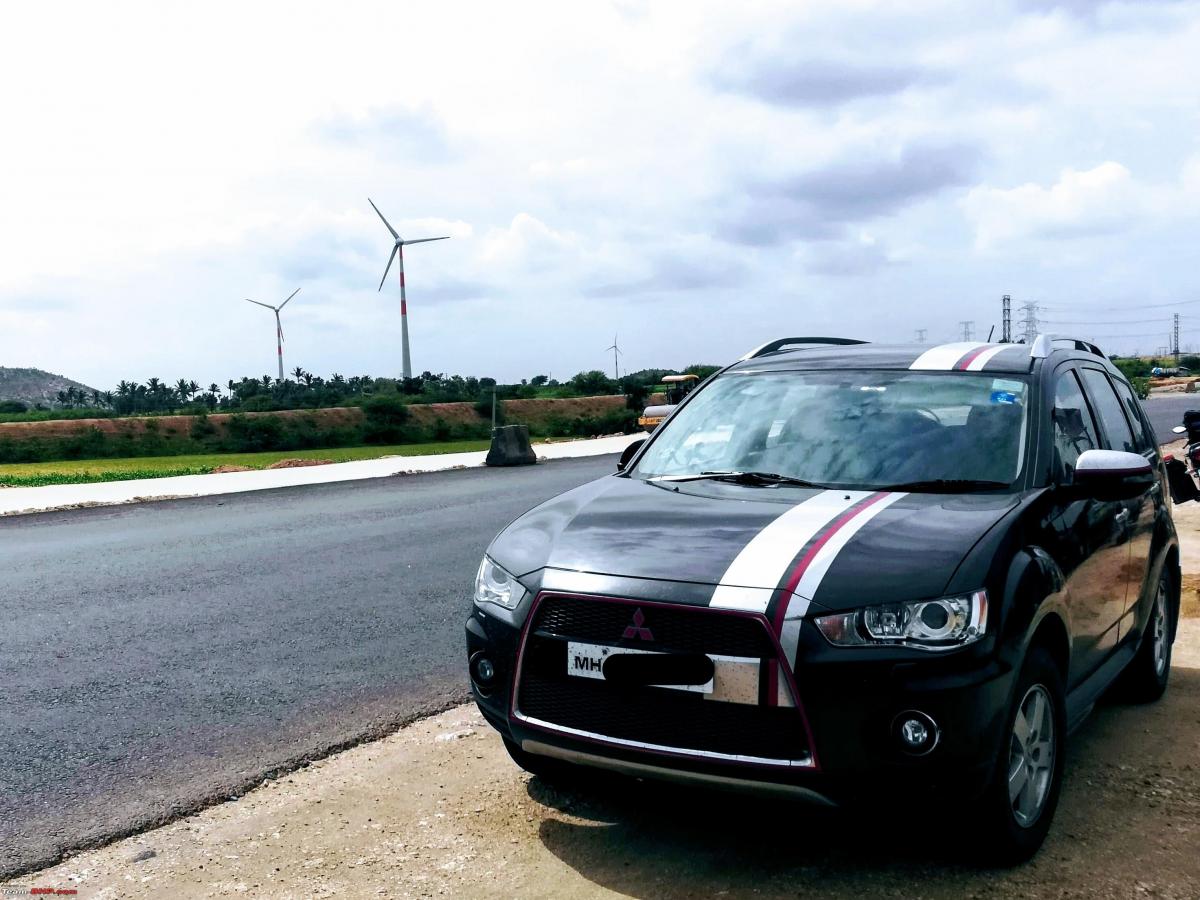
Munching miles. Facade filled with insect debris.

Got it wrapped (only speed lines) at 3M Kharadi Pune.
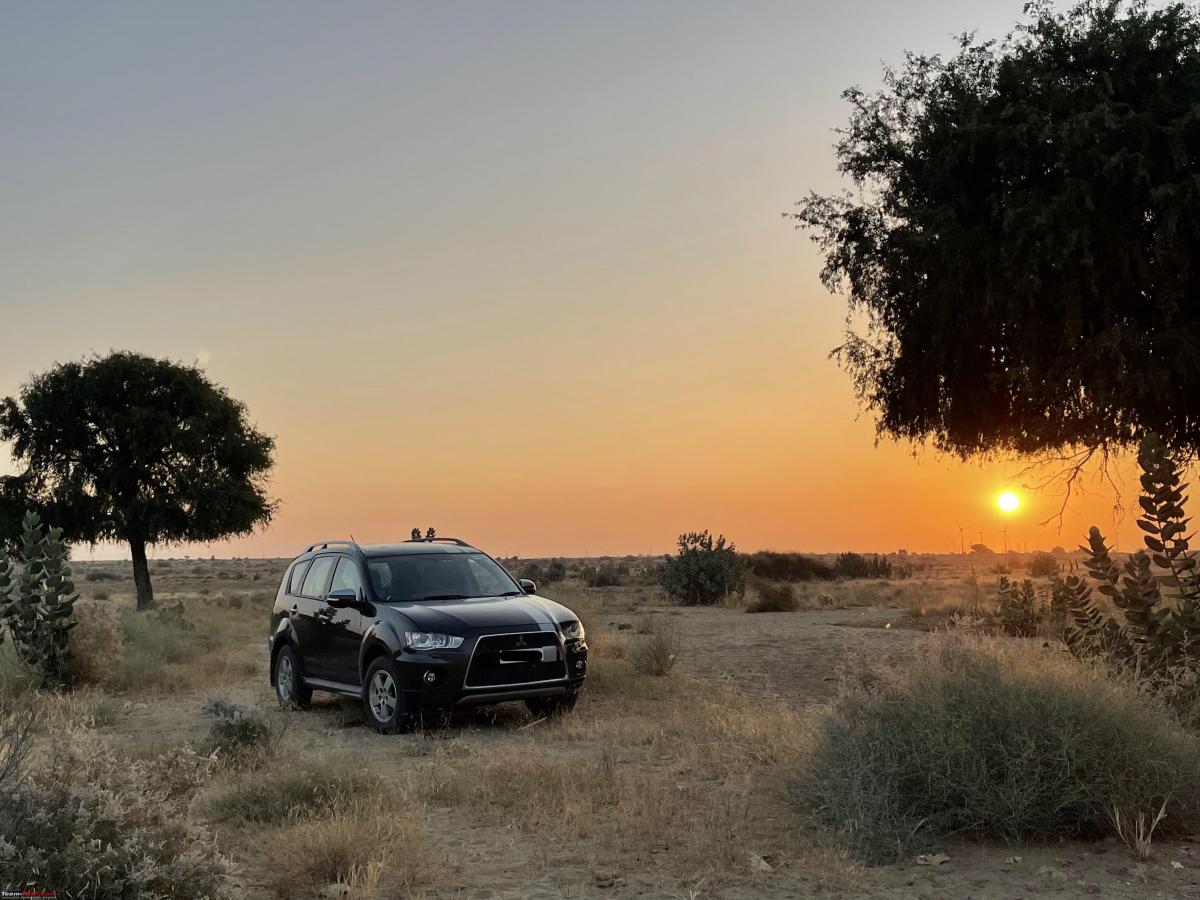
Sunrise somewhere in Jaisalmer.
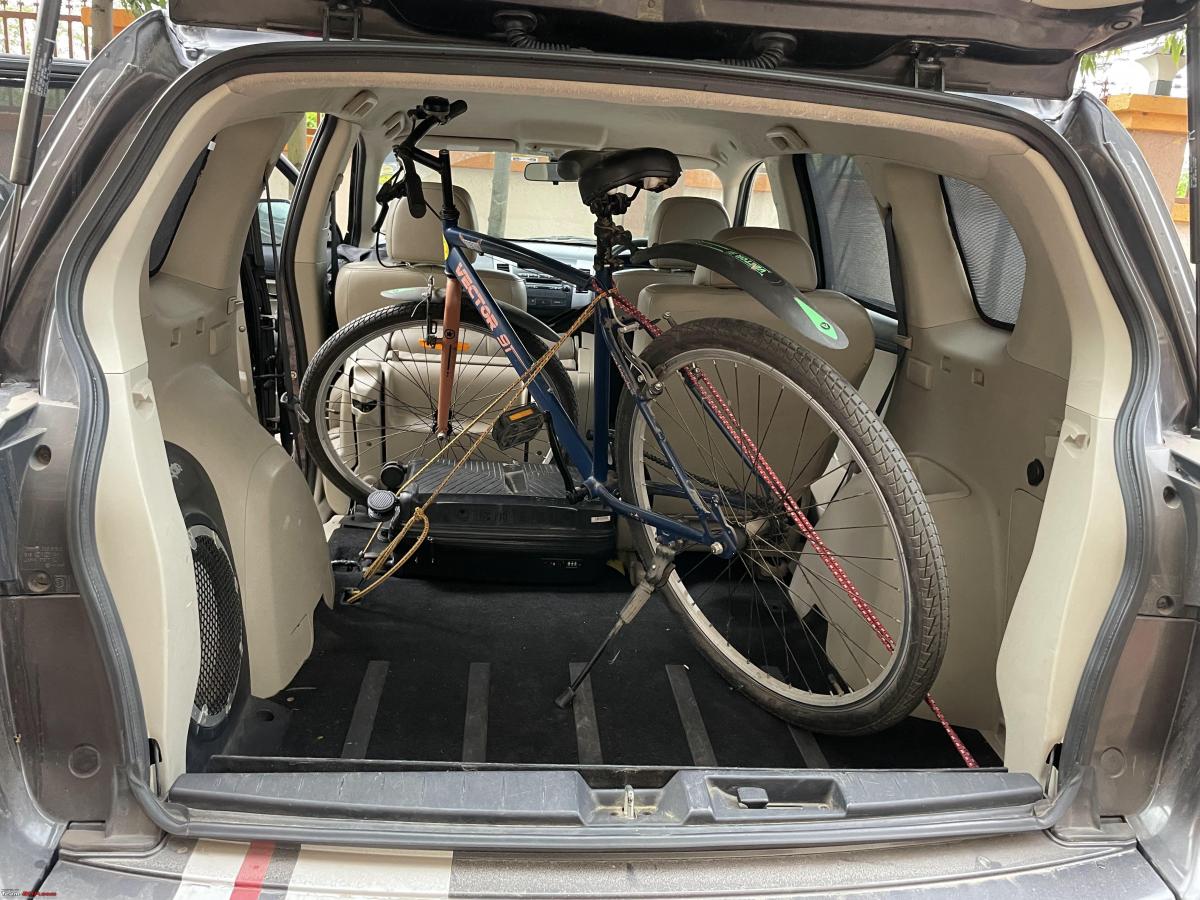
Fits a full size bicycle.
Check out BHPian comments for more insights and information.
- Tags:
- Indian
- Mitsubishi Outlander
- Petrol
- SUV
- AWD
News
My VW Polo GT TSI clocks 1 lakh km: Service & other maintenance updates
The mechatronic repair did not last too well and I was facing issues with the car on and off after 15k kms of the repair.
BHPian Viraat13 recently shared this with other enthusiasts.
Hello Bhpians,
I haven't been able to update the thread lately, however I've done 20000km since the last post.
More than a few things to report since then.
In terms of maintenance, I faced a major cut in the new Continentals. Thankfully, their warranty procedure is fairly smooth, so I got a replacement tyre in a few days at 65% discount (basis the tread wear).
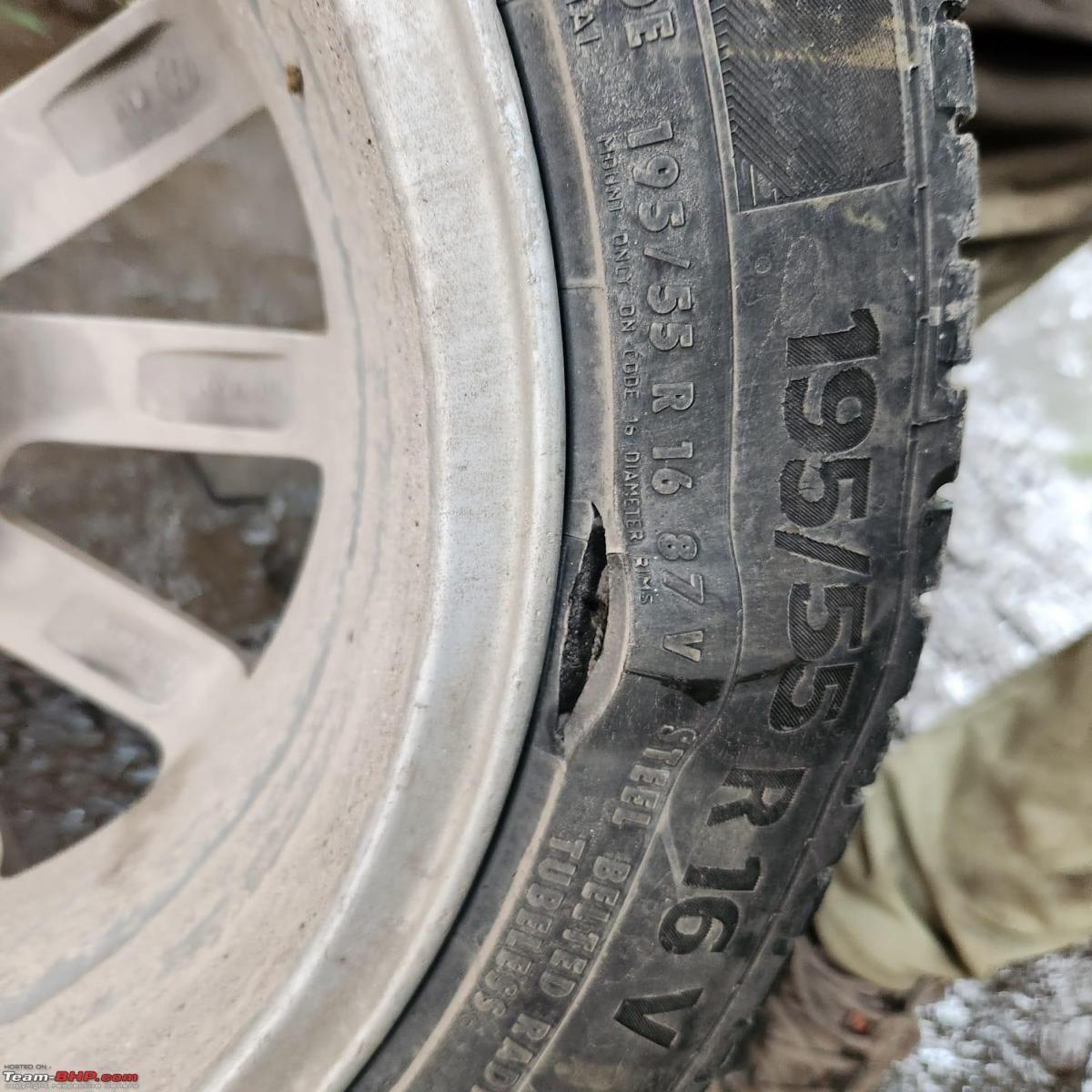
One of the rear wheel bearings had failed, replaced this with an OEM unit.
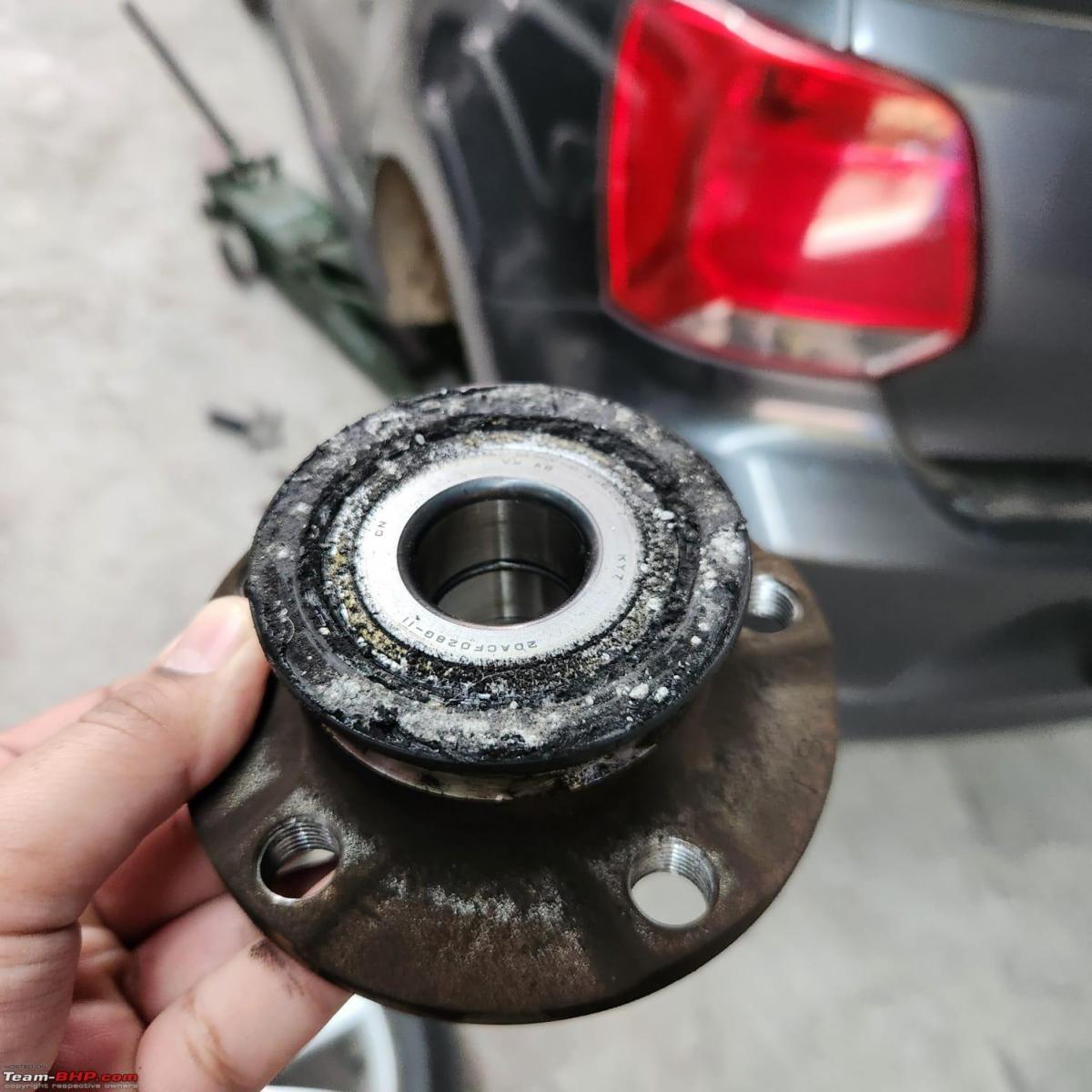
I didn't take any photos, but I also put in a new multiclutch (preventive) as it had started to fail and did give faults a couple of times while on longish drives in the city. The mechatronic repair did not last too well and I was facing issues with the car on and off after 15k kms of the repair. I considered using this as an excuse to replace the car, but I couldn't think of a logical replacement, and it's always cheaper to repair your current car than replace it. I got this done at VW, and the new mechatronic was around 86K.
As is usual of late, I did several trips on the highway. Some seriously dense fog at 6am near Agra in early December. This is around 6:30am.
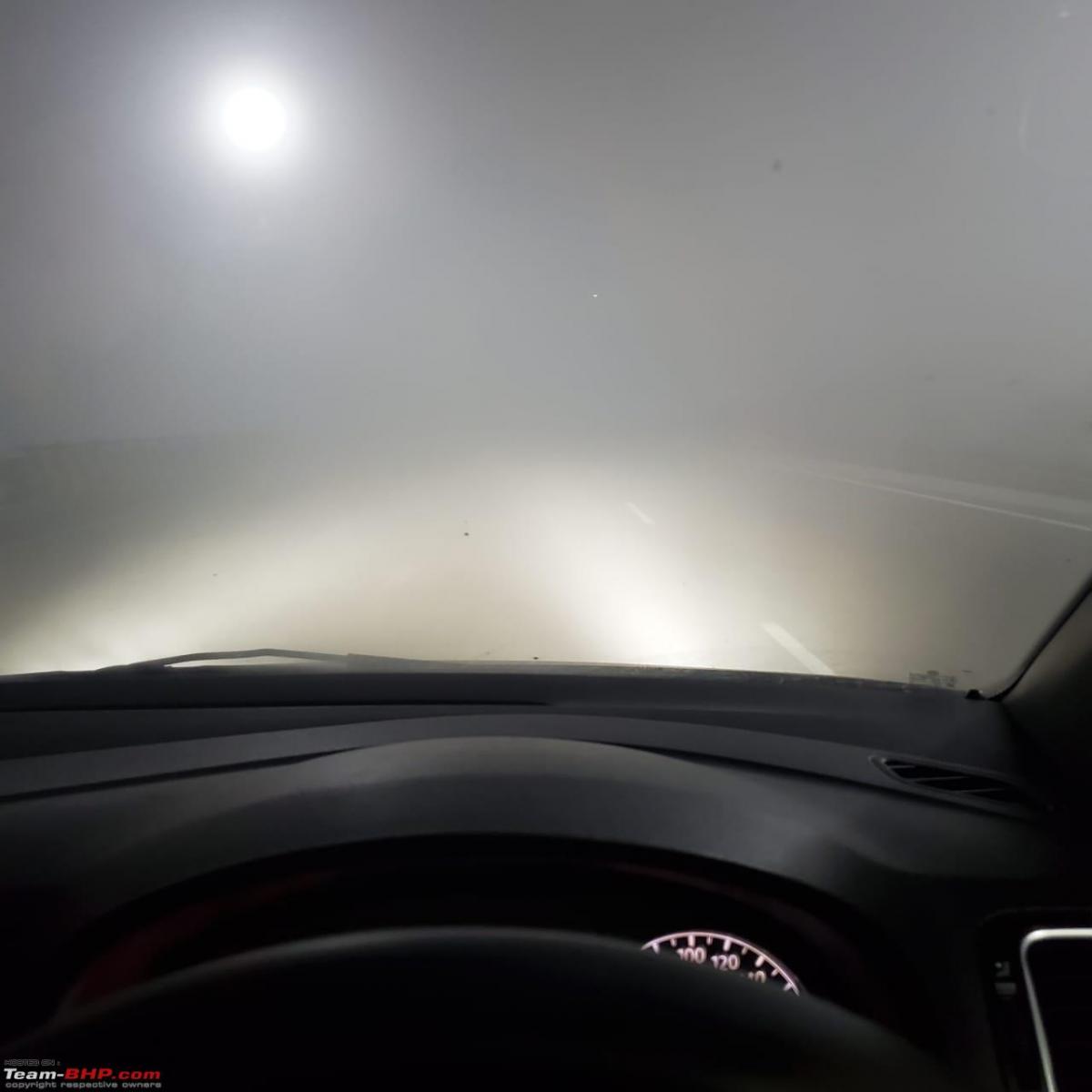
Despite its flaws, I still like how the Polo looks. It has really aged well. Might consider changing to the new bumpers/grilles at some point to make it look fresh again.

The Polo was at 90k on 19th May, 100k on 30th Aug, and 110k on 7th Jan
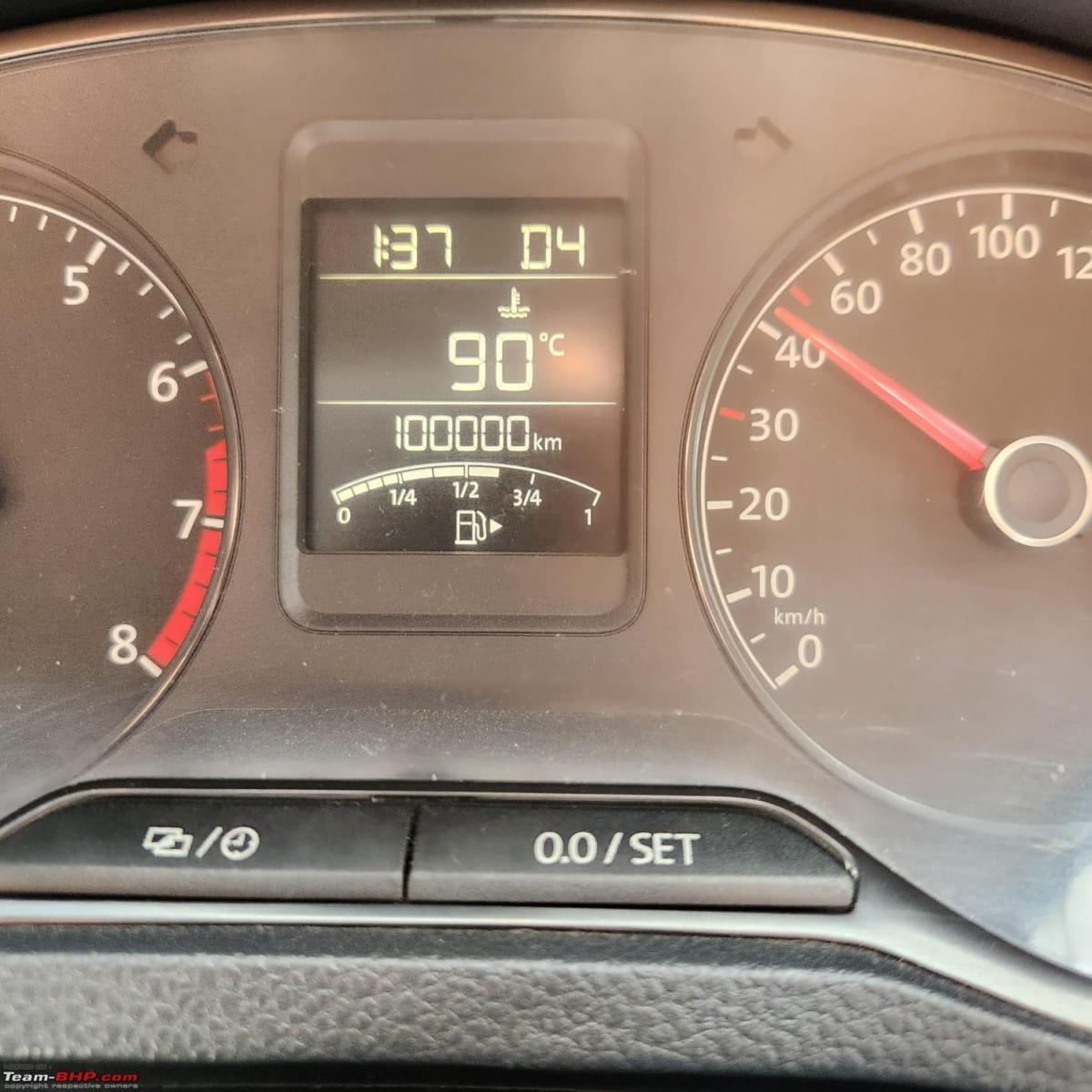
20000km in 230 odd days, probably a record for me.
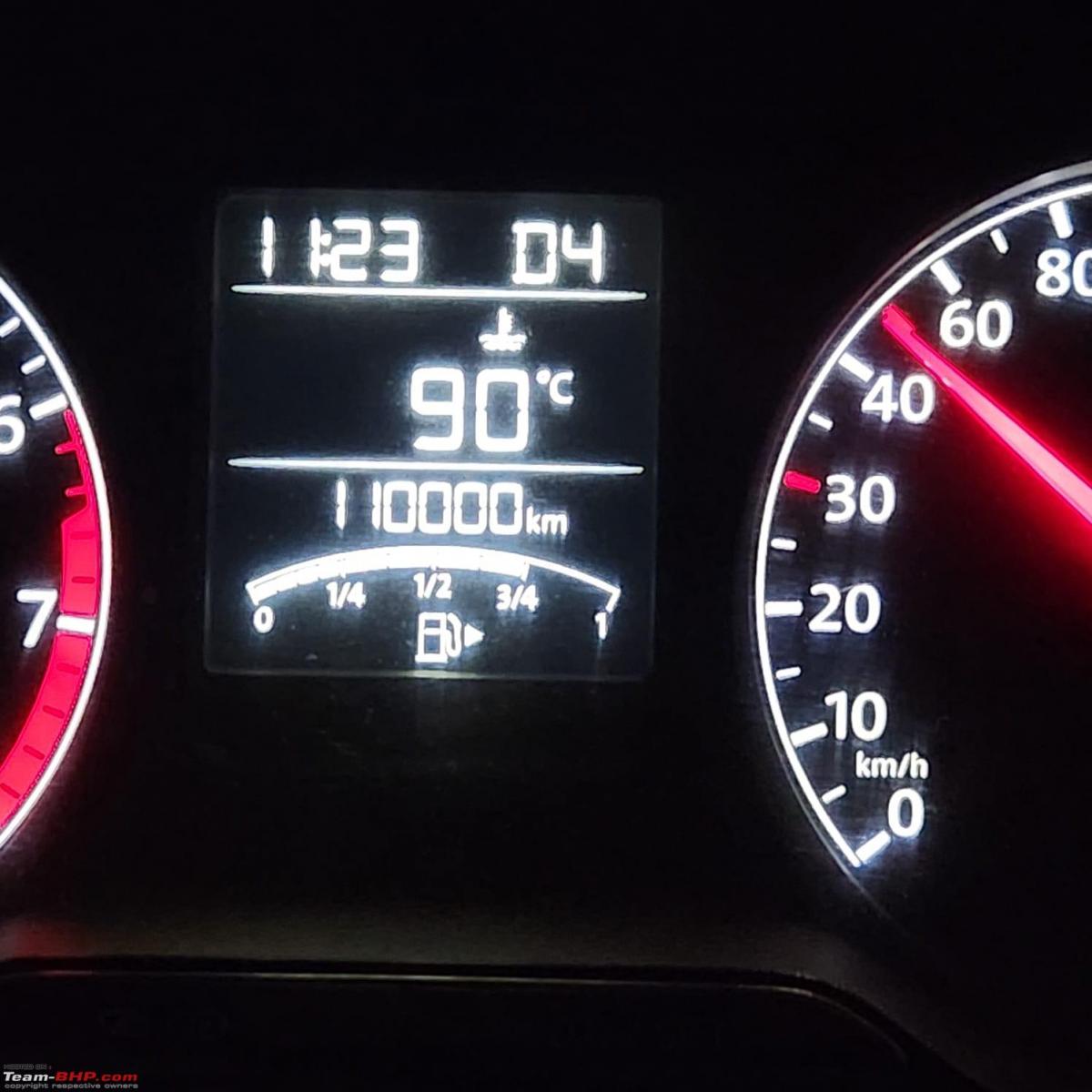
I'd also shifted operations to a new garage in the second half of last year, so it really has been busy.
Here is the car inside said garage. OEM oil filter, air filter, and AC filter. Fuchs 5w40 fully synthetic engine oil - my preferred brand of late.

Spark plugs need to be replaced, and so does the fuel filter. Should get around to it in a few days when I get fresh stock.
Looking forward to the next 10k kms, as the car is unlikely to need maintenance money.
However, that should take me 6 months or so as I'm planning to use my Skoda a bit more instead.
Wish you all many happy miles.
Check out BHPian comments for more insights and information.
News
In pics: Got the 2nd service done on my Skoda Kodiaq TSI at 24000 km
In future I am even contemplating to get an oil change at 7.5K kms & regular service at 15K difference.
BHPian SilverSmoke recently shared this with other enthusiasts.
Got Avalanche's second service done at 24K KMs.
Got a new lease of life - engine got hyper smooth & very responsive. I highly recommend don't wait for 15K KMs for an oil change - get it done by 10K KMs - strictly. We just keep slushing the engine in high viscosity oil past 10K KMs - don't know why Skoda has recommended that at 15K KMs.
In future I am even contemplating to get an oil change at 7.5K KMs & regular service at 15K difference.
Here comes out the old, dark & restricting oil:

That goes the fresh, clean & transparent dose of engine's blood - difference is clearly evident.

The grade of oil used. 5.7 litres of it

That's the DSG transmission underneath - with black cover over mechatronic unit in front.

Cabin air filter. Dont know if its HEPA or not:
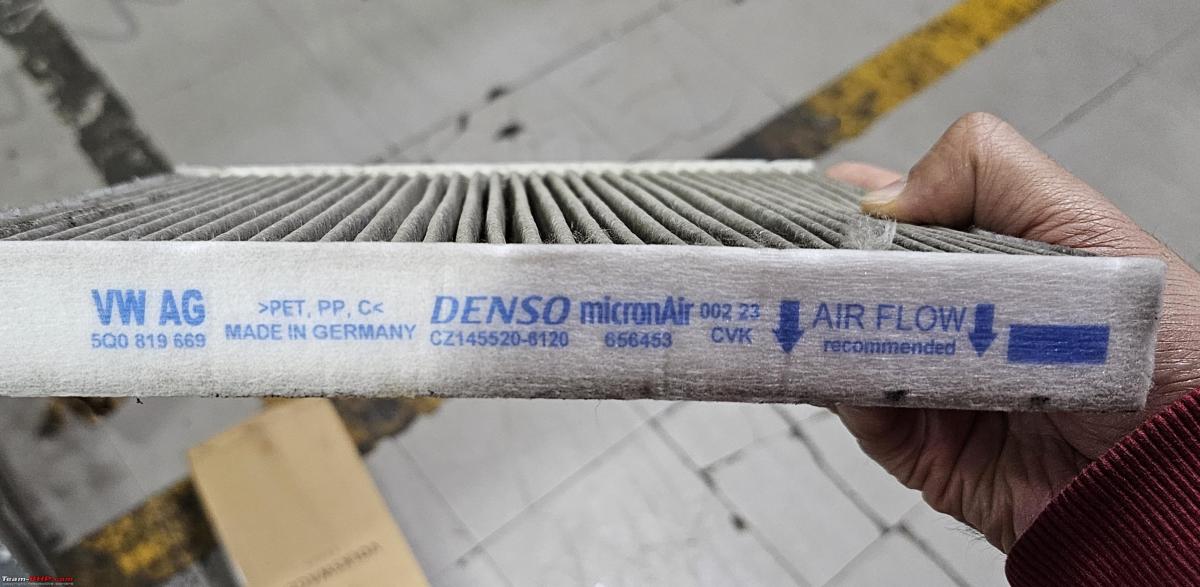
The choked side, thanks to rising air pollution:

Remaining brake pads - guess they will be good for another 25K KMs. If they are to be replaced with disc - they will set you back by ₹75K:

The fluid that was poured into wiper washer compartment. Can't understand what's written - used Google translate, turned out to be - Summer Mix for Washer:

Just a minor issue cropped after software update this service - ORVMs now don't dip down while shifting to reverse - hoping for it to get corrected soon.
Check out BHPian comments for more insights and information.
News
Long time Maruti Gypsy owner buys a Jimny: Shares key comparison points
The DNA has not changed, it still behaves like a 410W Gypsy does. Only it is better in every single aspect.
BHPian antihero recently shared this with other enthusiasts.
With the recent 2L price drop, the Jimny is a good contender for the next 15 years of bad-roading in the mountains.
More than the price its the constant government interference with old vehicles that is disappointing. Reusing a well-maintained old vehicle is much more environmentally friendly than an EV for that matter.
But I digress, the new Jimny is here, bought cash down in one day as they had my favourite colour available. To celebrate I took it for a 900 km trip in the mountains. Compared to the 410W here area few key observations:
- The DNA has not changed, it still behaves like a 410W does. Only it is better in every single aspect - suspension, engine, comfort... the lot.
- The biggest change is the suspension especially over rutted roads and gravel, especially the fist sized gravel so common in the mountains. The Jimny can hold its own on such trails, no more shuddering and bone rattling jerks. The suspension is a good two generations advanced from the original 410 and that alone is worth the money.
- There is transmission whine (see DNA) there is the 4wd lever shake, just not as much. Like i said improved.
- The launch price for the zeta model (rural model as i call it) should have been 9.99L. Alpha has upgrades for the urban environment like alloys, request sensor etc that has no bearing in rural areas.
- The steel wheels look excellent and are reasonably strong
- The stock tires are geared towards mileage. If you live in a city they work just fine. In the mountains not as much. Which is why I upgraded to the best I could find locally - Conti Cross contact in the "correct" size 215/75R15


Original tyres


Continental AT tyres in the right size!
The old 410W stays home. While i had the option of giving it away as exchange or to scrap it (thanks government). I think the old girl has deserves a life as a senior citizen in the estate. It will not be mollycoddled but will trudge on doing what it does best, being there when the snow hits the fan / heavy monsoons.
I have got a trickle charger just for its battery and 4 body jacks to keep it elevated.
I will also keep the thread alive because there are a lot of old tales to tell about this wonderful machine and the places it has taken me.
Maybe another thread about the Jimny from the perspective of an old Gypsy fart who has used it as a primary car for the past 10 years? Let me know if you think it will be relevant for you.
Check out BHPian comments for more insights and information.
- Tags:
- Indian
- Maruti Gypsy
- Maruti jimny
- 4x4
- SUV
- Petrol
News
Brought home a BMW X3 M40i: Here's what I like about it & what I dont
Handles like a sedan. Wonderful body control around corners and has decent ride quality.
BHPian XDriver recently shared this with other enthusiasts.
Hello fellow BHPians!
In Nov 2023 I brought home the BMW X3 M40i to replace my X1 X Drive 20d M sport. I already have the BMW 530d M Sport G30 face lift LCI. So I was in the look out for an SUV to replace my X1. The cars I short listed were the new X5 40i and X3 M40i. Some well wishers suggested the Porsche Macan too. But as there is no dealer of Porsche in Hyderabad yet and the Macan is way too expensive for a base version (which is a 4 cylinder which was offered to me for 1.1 CR by the Mumbai dealer) I decided to drop it.
Front view:
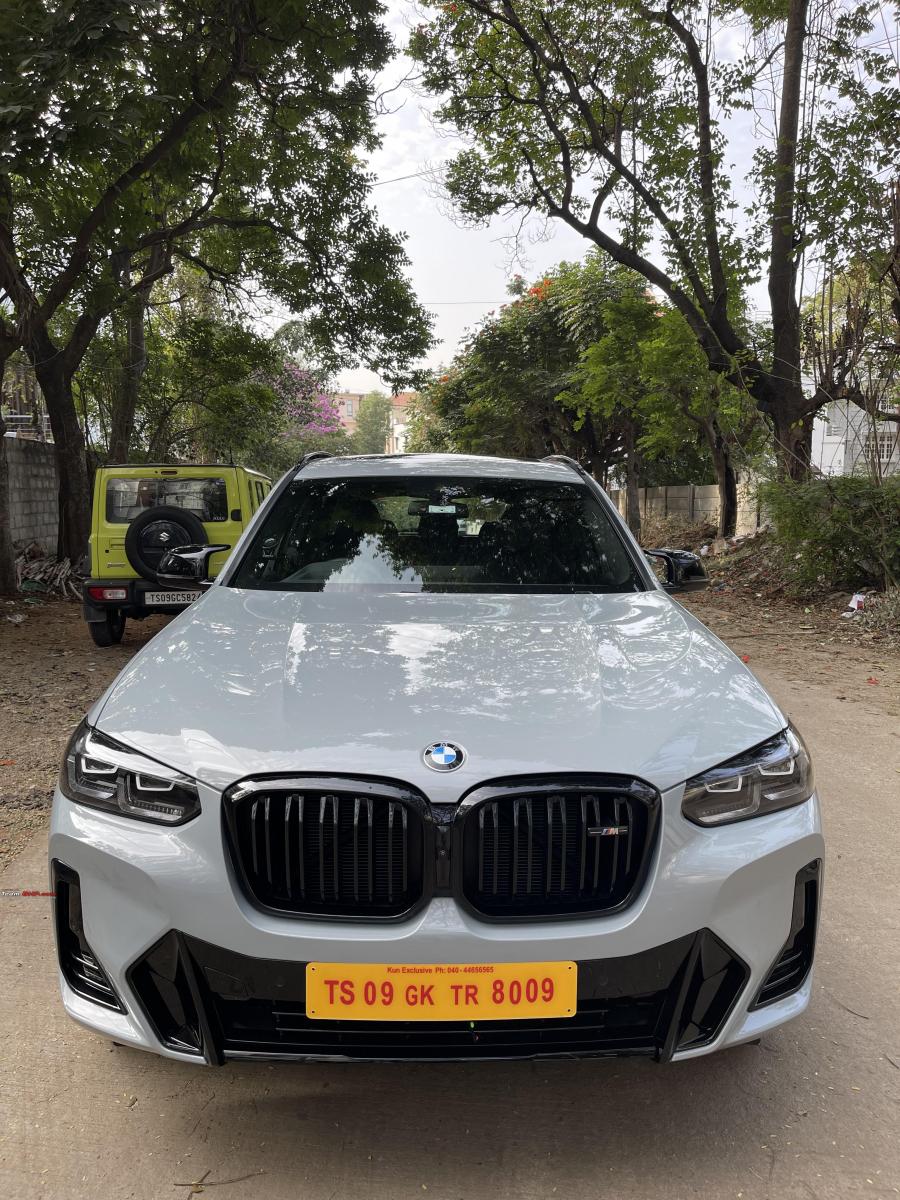
Rear view:
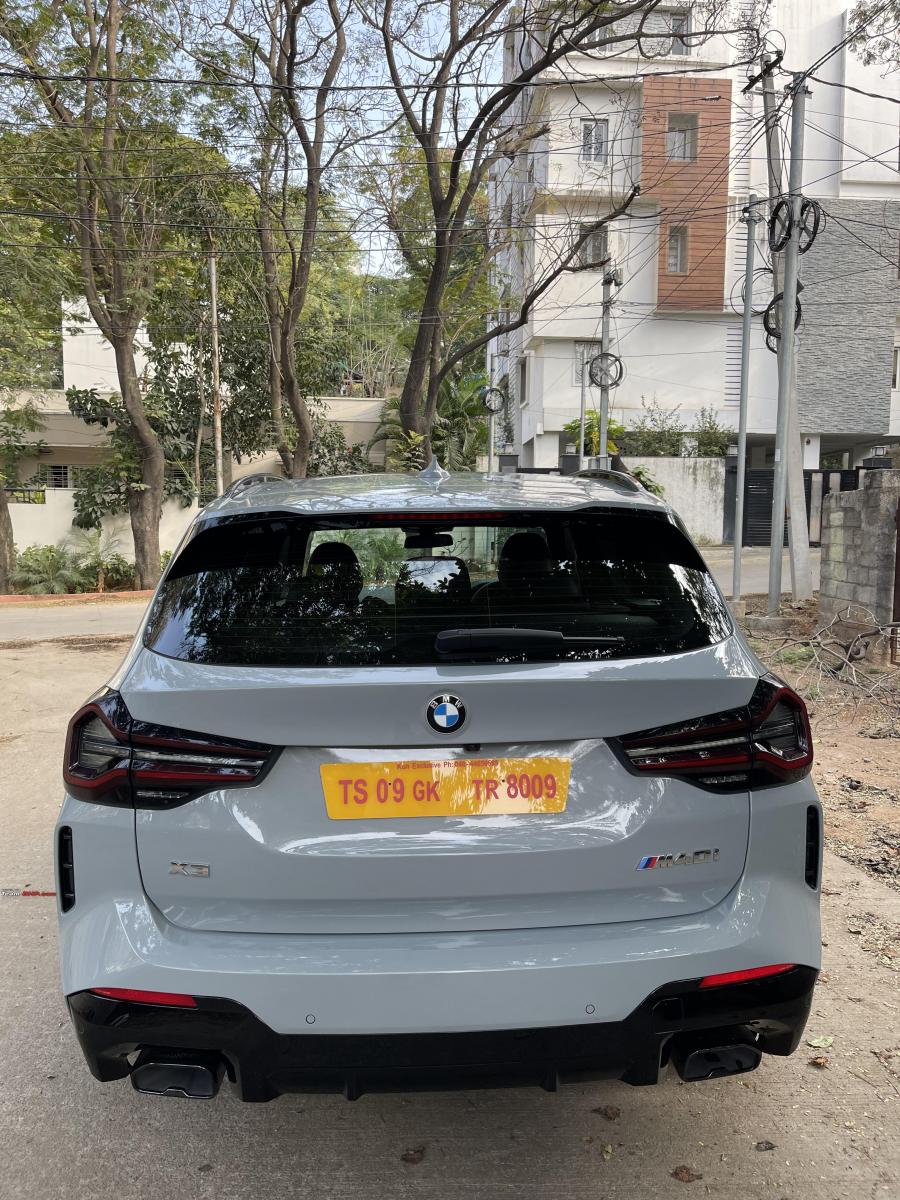
Side view:

B58 engine bay:

The 2 BMW siblings together. In-line 6s. One diesel and one petrol:

Test drove both the X5 and X3 in 40i versions. I have posted my views on the X5 earlier in the forum. The team BHP poll suggested the X5 for the superior build quality and better ride and comfort but I decided to go for the X3 M 40i as it was sportier to drive, fits better in my parking space and the discounts I got. Thanks a ton to all who voted in the poll and gave valuable suggestions.
Overall am very happy with my purchase.
First thing was to get PPF and ceramic coating done for the car with Kavaca. Applied the 3M rodent spray in the engine well and wheel arches. I do this regularly every 3-6 months for all cars. (Had a rodent bite to the washer fluid tank on my X1) one has to learn from experience and now this is a ritual for me.
What’s to like:
- Beautiful design, proportionate and balanced. Perfect size and style of the double kidneys.
- An enthusiasts car. The legendary B58 in-line 6 cylinder with 360hp and 500nm torque is just brilliant to drive and sounds terrific (better than the X5 40i)
- Spacious and practical. Sporty all-black interiors with carbon fiber trim.
- All the bells and whistles like 360 degree camera, parking and reversing assistant, 464 W Harman Kardon system (though needs a bit of tweaking in equaliser to get best out if it)
- Handles like a sedan. Wonderful body control around corners and has decent ride quality. M Sport differential and M sport brakes aid in composure and stopping.
- Good ground clearance with 500mm water wading.
- Adaptive dampers gives a decent ride
- Mild hybrid system (though not mentioned in brochures)
- M Mirror caps and blacked out twin exhaust tips
- Exclusivity as it will be available in limited numbers
- No annoying speed warning chimes at 80 and 120 as I guess it’s a CBU. I was so pleased with this!
- Presence of physical buttons for climate control, short cut buttons. I use the latter as speed dial presets.
- Massive panoramic roof gives an airy feel to an otherwise dark interior and acoustic glazing of windows helps keep unwanted noises out.
- Sun blinds for rear windows (manual) which is missing in M340i
What’s not:
- No request sensors on doors for a 1 CR plus car
- Misses the latest curved screen displays with iDrive 8 of newer models. I actually like the iDrive 7 better so not a deal breaker for me.
- Stiff ride but better than M340i as it has adaptive dampers
- Reduced boot space from 550 litres to 480 litres due to stowed spare tyre
- Cheaper hard plastics on lower sections of doors
- Expensive as it’s a CBU
- Loves to guzzle gasoline especially if driven hard but that’s the point of buying this car. FE of 7-8 kmpl average.
- RFTs
- No BMW digital key or ADAS
- Minor niggles. Have a rattle in the left front door. More on that below.
Interior design:
Though its interior is older design it is extremely well put together. It feels robust, the older screens with iDrive 7 with physical controls are more practical and still upmarket. The drama of the newer curved screen is missing but iDrive 8.5 has may menus and sub menus and not as intuitive as iDrive7. The black interior with carbon fiber trim is sporty and looks good. The sport seats hold you snug and are yet comfortable. Leg room at rear is more than adequate (almost similar to X5). Wireless charging pad is nice to have (though seldom used). X3 a M40i only comes with black sensatec letherette seats. More colour choices would have been nice but black will be easy to maintain. The black interior goes very well with the Brooklyn Grey exterior paint colour though.
The Cockpit:
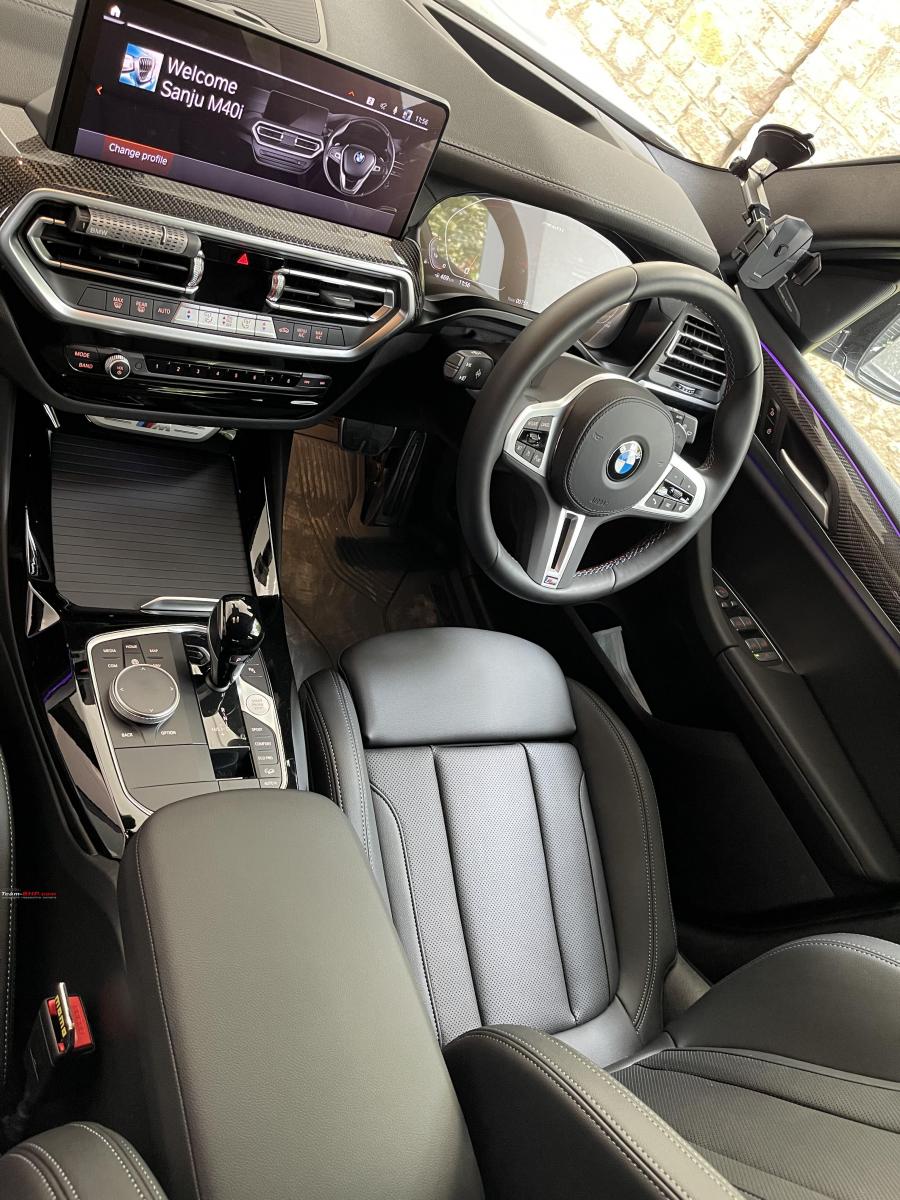
The M Sport Steering:
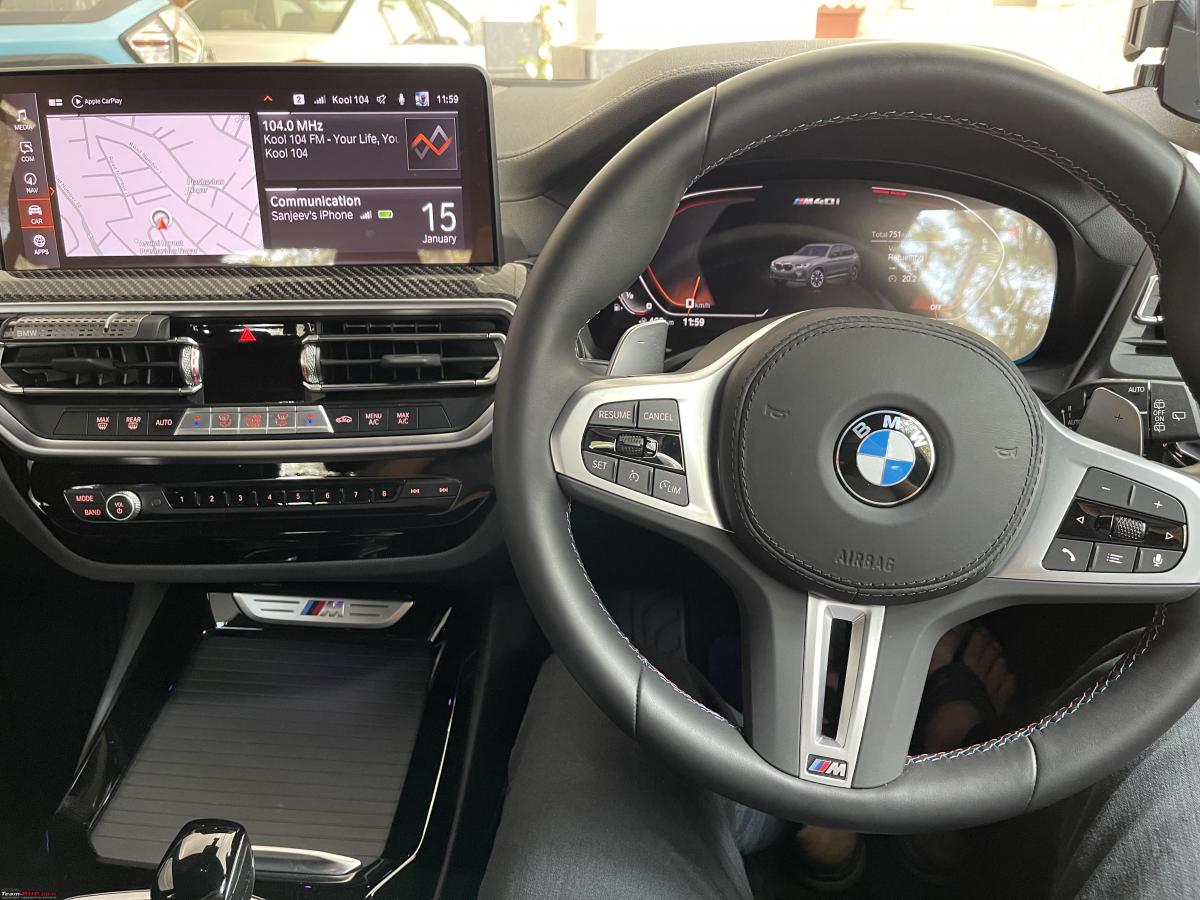
Front seats:
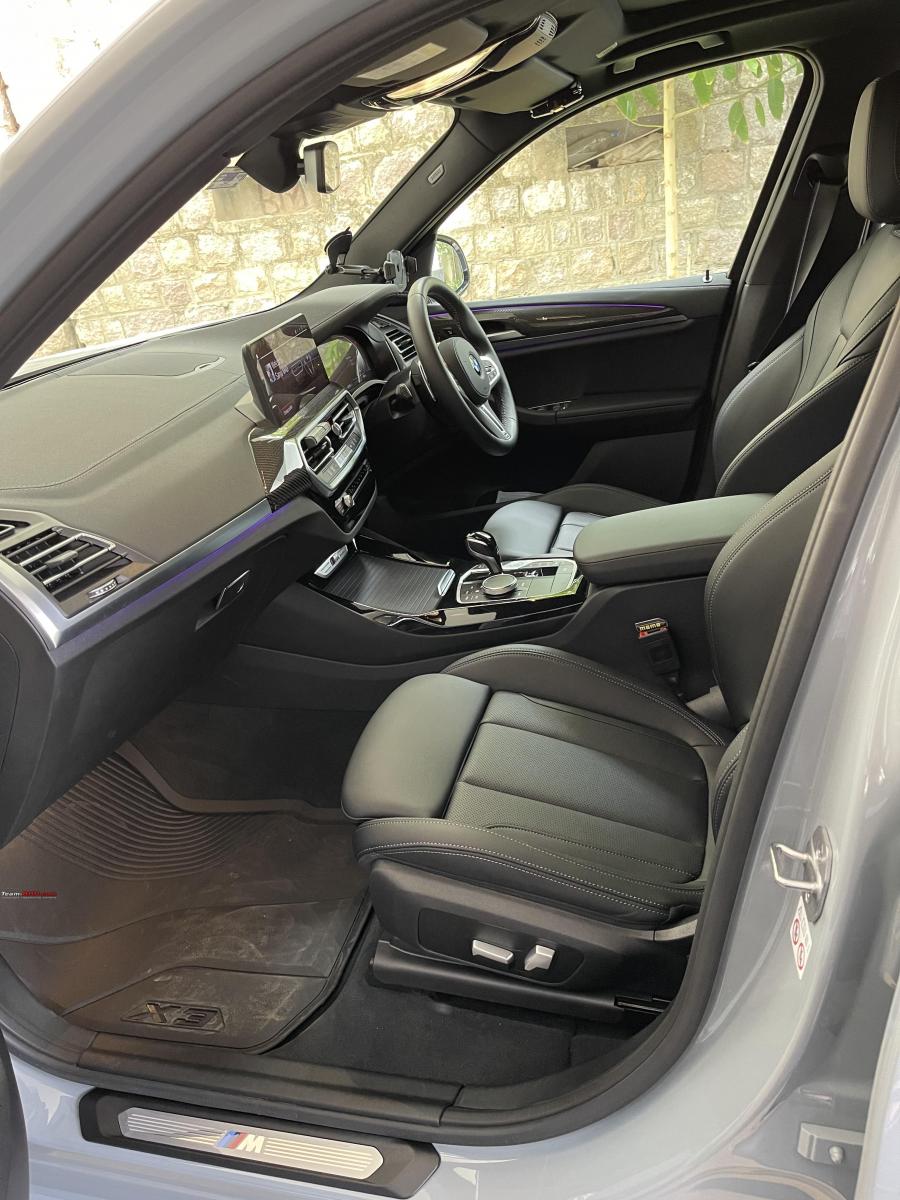
Rear seats and space:
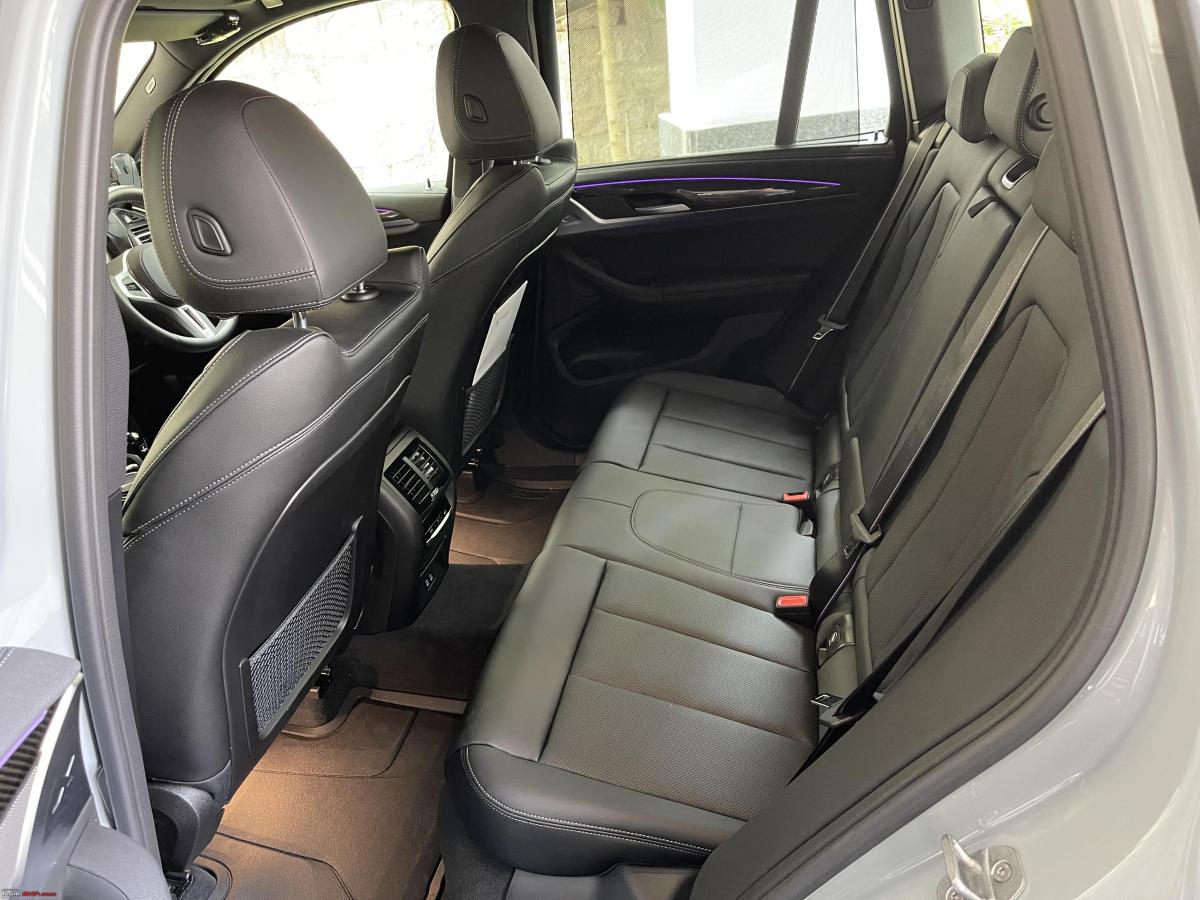
Exterior design:
Exterior looks are pleasing and the Brooklyn Grey metallic paint with black M grill, M style door mirrors in black, piano black bumper, rear diffuser with shadow line lights look fantastic. It has a very clean design with an aggressive sporty front and rear end. What I can say is the X3 design is proportional and balanced. The LED lights have the shadow line package with adds to the sporty appeal. The 20 inch light alloy wheels with red callipers suit the car well. What’s impressive is the smaller foot print of the X3 vs X5 that makes it more convenient for daily self driving and parking in cellars and on narrow roads.
Aggressive front:
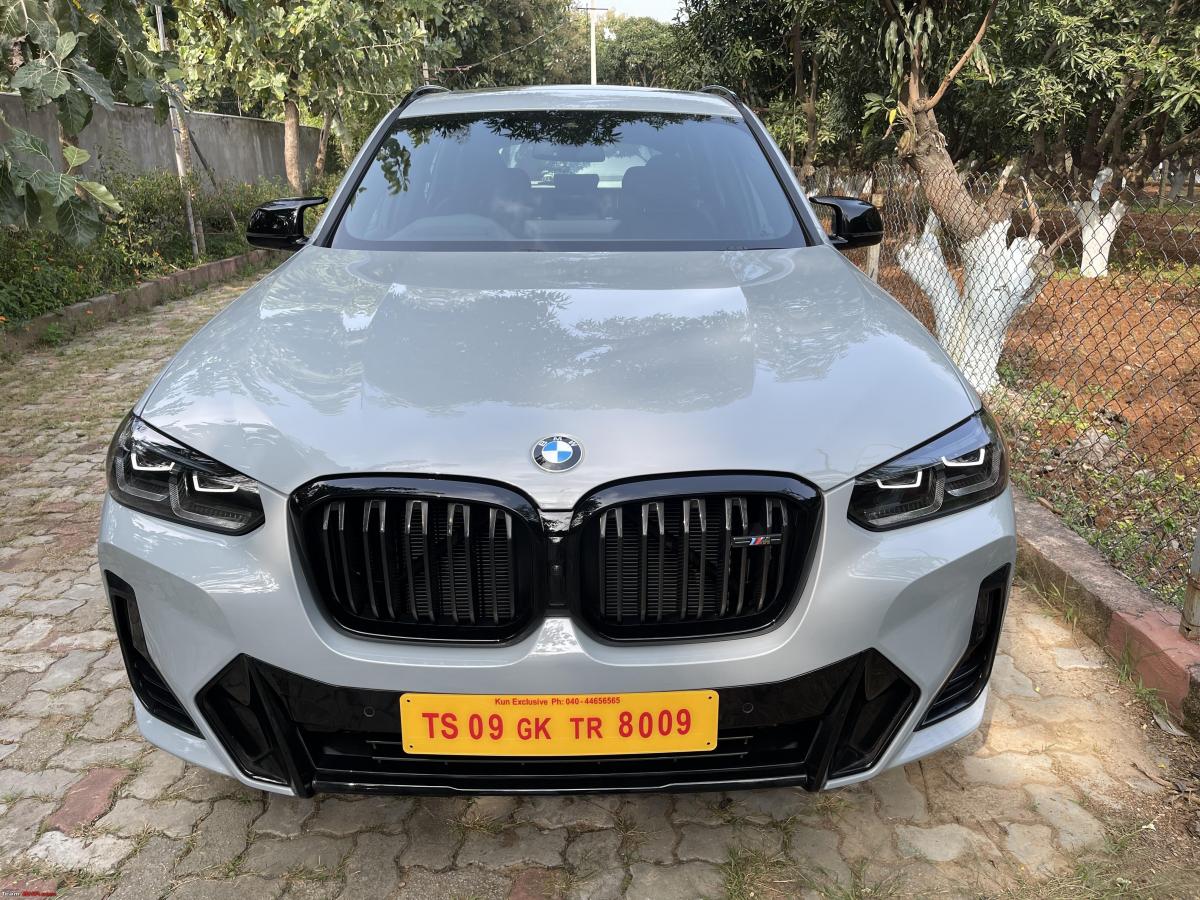
LED headlamps and M wing mirrors:

Rear 3/4 view:

M40i badge:

20 inch M light alloys:

Shadow line tail lights:
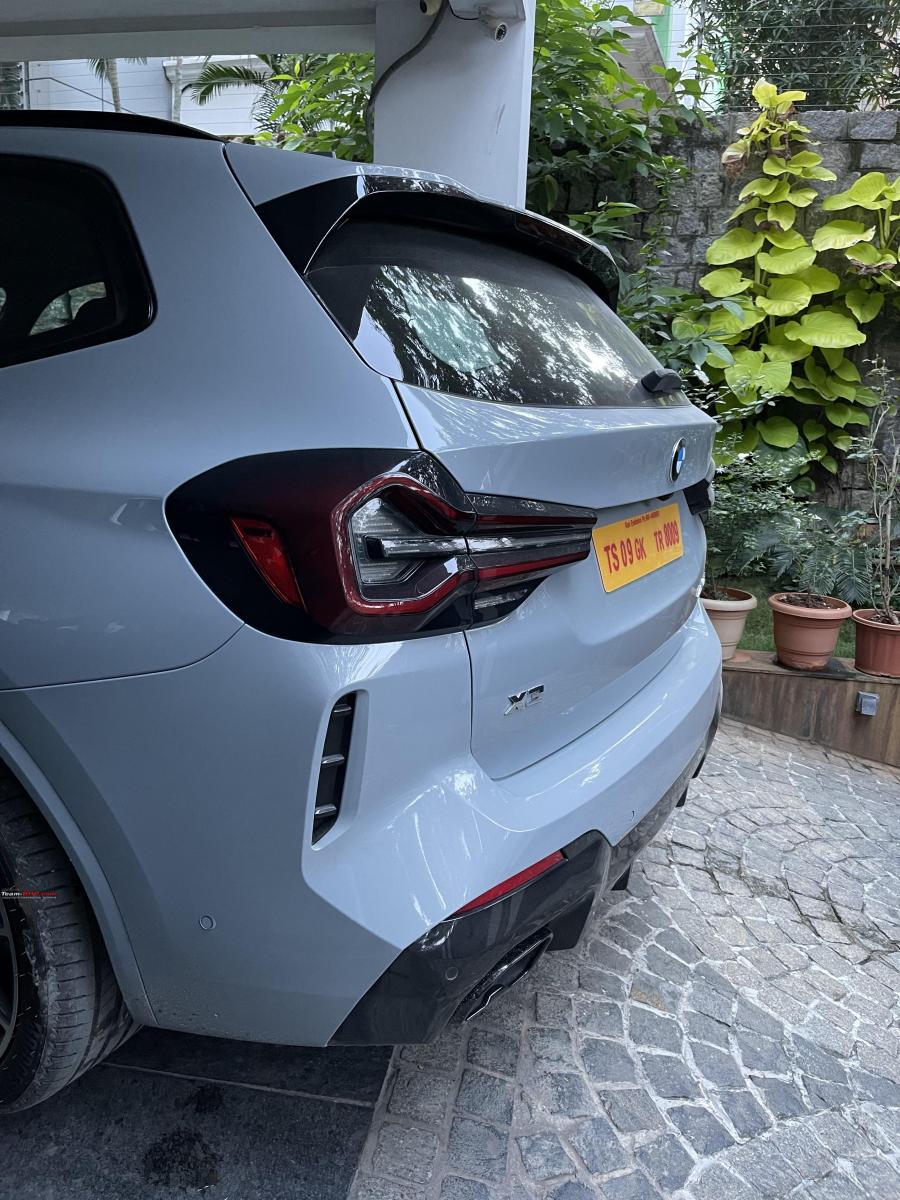
Tail light signature:
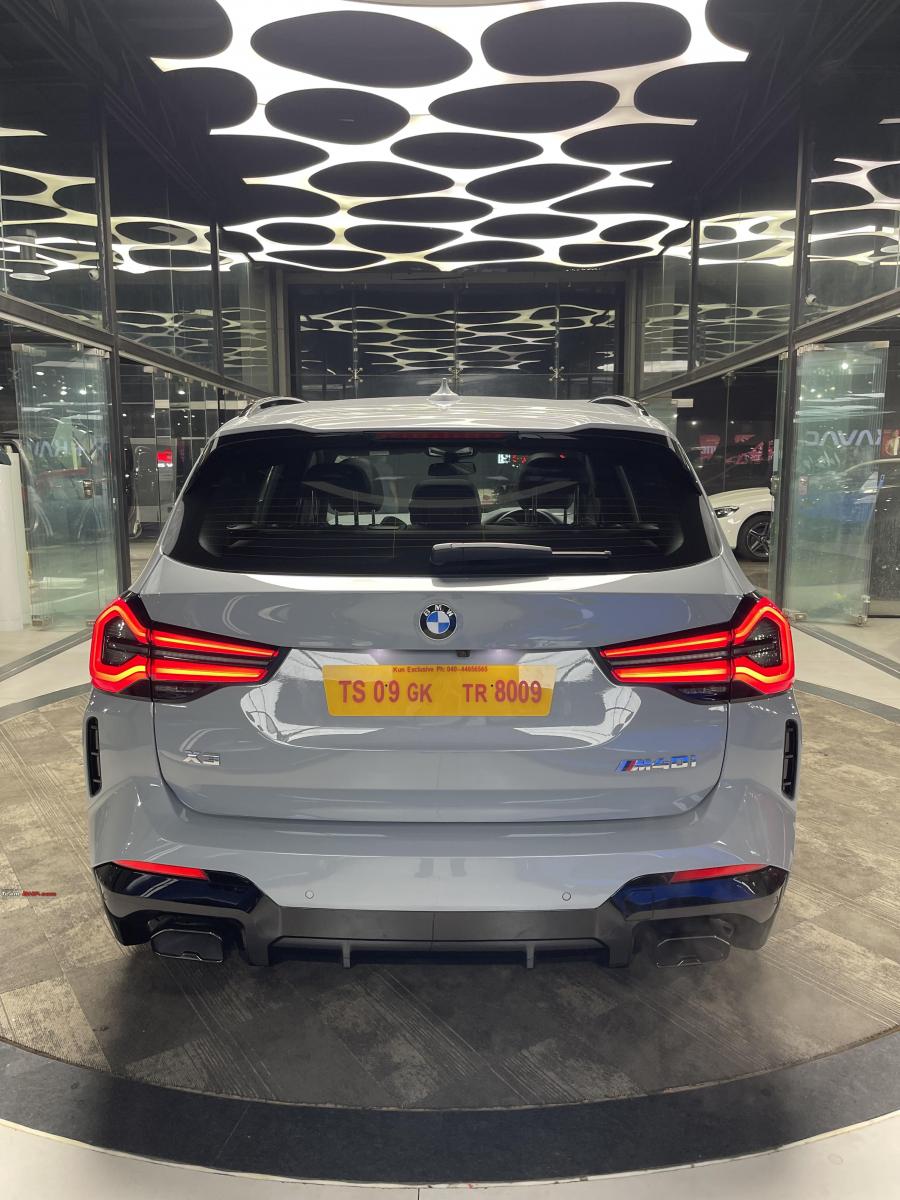
Drive and handling:
The main reason for me to upgrade from X1 X line 20d was the B58 in-line 6 engine. I know these engines will soon go out so wanted to own one asap. The M40i has the slightly de-tuned version with 360bhp vs the 374hp unit in M340i(really don’t know why) but the difference is not felt in daily usage. The claimed 0-100 time is 4.9 seconds but I have not tested it yet as the vehicle is still in the run-in period. In comfort mode it is super smooth, with excellent NVH, and is very responsive. Just a light touch in the A pedal it just surges forward without fuss. It has a dual personality like the M340i. It’s calm and composed in comfort more and transforms into a hooligan in sport mode. It’s a proper sleeper vehicle and will take people by surprise with its brisk acceleration and sound. In sport mode the exhaust and engine sounds are louder (maybe a bit pumped in via speakers). The A pedal response and gear shifts are more sharp and in no time it will zoom into triple digit range. The suspension also firms up and is stiffer in sport mode. You will feel every bump, crater or expansion joint in sport. Heck, you could even pick out a needle or dropped coin by going over it. Better to go into sport individual and keep engine and gearbox in sport and suspension and steering in comfort. The FE will drop to 5-6 km in sport mode if driven hard. I am averaging 7-8 in mixed city and ORR driving. The absence of irritating speed warning chimes allows one to enjoy the car even more uninterrupted.
The folks at KUN BMW were not aware of that it has a mild hybrid system. But it seems to have it as I see a purple cable (indicative of mild hybrid) running behind the engine and the car RPMs drop to zero while coasting. Also turbo lag is barely felt. Please correct me if I am wrong.
Handling is tight around bends and body roll is negligible. Overall the X3 m40i drive is nimble, firm yet decent and is very responsive and a hoot drive. The RFTs I have are Bridgestone ones. Wish I have the Michelins (as on my 530d) which I feel are better. I plan to continue with RFT till I wear these out. Then may go for tubeless in future.
Build quality:
Build quality isn’t on par with the X5. The Sensafin seats are better in X5. No hard plastics anywhere in X5. Doors on the X5 feel more solid and ride comfort is superior. I have the 530d which is better built (just like the X5) and it compensates for the X3 for me on luxury factor.
Niggles:
Now the niggle part. I have a rattle in the left front door. KUN BMW sent the engineer home to check it out and after some test runs figured out that a screw and washer that holds the side skirt to the door is missing from inside. Didn’t expect this from BMW. They have ordered the part and it will take 2-3 weeks to come from Germany. It’s very annoying to drive with the subtle rattle. Someone with even mild OCD will be pissed off. I have attached a pic below of the missing part.
The missing screw and rubber bush:

Hope this clears some doubts of those considering this performance SUV.
My garage now has the turbo diesel and turbo petrol 6 cylinder BMWs and an EV (Tata Nexon EV) which is our beater city car.
Check out BHPian comments for more insights and information.
- Tags:
- Indian
- BMW X3 m40i
- SUV
- Petrol
- turbo
News
My Maruti S-Presso: Updates and upgrades at the 1000 km mark
Fuel efficiency wise it is an absolute star, averaging between 22 to 23 kmpl over the last thousand kilometers.
BHPian antihero recently shared this with other enthusiasts.
1000 km up:

In a plot twist dictated by the weather gods - read no snow, the S-Presso has taken the reins in Jammu and Kashmir, outshining the Jimny. While the Jimny reigns supreme in the realm of snow-covered terrains and challenging off-road adventures, the S-Presso emerges as the everyday champion, ready for any task.
Do not be deceived by mere ground clearance and power figures; the S-Presso is no lightweight. It matches, and often surpasses, the capabilities of soft SUVs like the Mahindra XUV or Hyundai Creta on rugged roads. Its compact size and truncated overhangs provide an unmatched agility—a worker bee tirelessly buzzing through tasks, as brilliantly articulated by @shankar.balan.
The tiny gear knob, a charming throwback, snugly fits in your palm, reminiscent of classic jeeps. The gearbox operates with the smoothness of butter, and the clutch demands minimal effort, even in the chaos of bumper-to-bumper traffic.
While the gear slots lack the mechanical thump, the manual transmission remains the undisputed choice for rural roads. The soft clutch, effortless gear shifts, and a sense of control make it the preferred option, especially when the road demands finesse. In icy conditions, second gear and clutch finesse become your allies, showcasing the importance of a manual gearbox in such scenarios.
However, a perplexing issue arises: the dwindling emphasis on fog lamps. In a car tailored for tier B and rural areas, fog lamps are not an indulgence but a necessity. Incorporating spaces for fog lamps, coupled with high-quality accessories akin to those on the Jimny, could have been a game-changer.
The order of the day is a genuine Maruti accessory boot mat—a game-changer when transporting rural essentails like sacks. The surprisingly capacious boot effortlessly swallows four duffel bags. Next on the agenda: carrying my bicycles, an experiment that promises interesting outcomes.
The S-Presso is the Goldilocks of cars—just right for two, manageable for four, and accommodating five only in emergencies. Loading it up with passengers doesn't faze it, showcasing consistent traction and engine performance.
For highway cruising at around 80, the stock 165 profile tires are more than sufficient. Kudos to the Continental CC6 tires for their whisper-quiet performance, a marked improvement over the stock MRF tires.
Winter brings its own set of grievances: the absence of a rear defogger and wiper. These are not optional but crucial safety features. Meanwhile, the inside rearview mirror (IRVM) is undergoing an upgrade tomorrow.

Headlights have undergone a Philips halogen transformation—a modest improvement but not quite reaching the desired level. Contemplations are underway for a bolder move with a 100W (50x2) LED setup for that extra oomph.
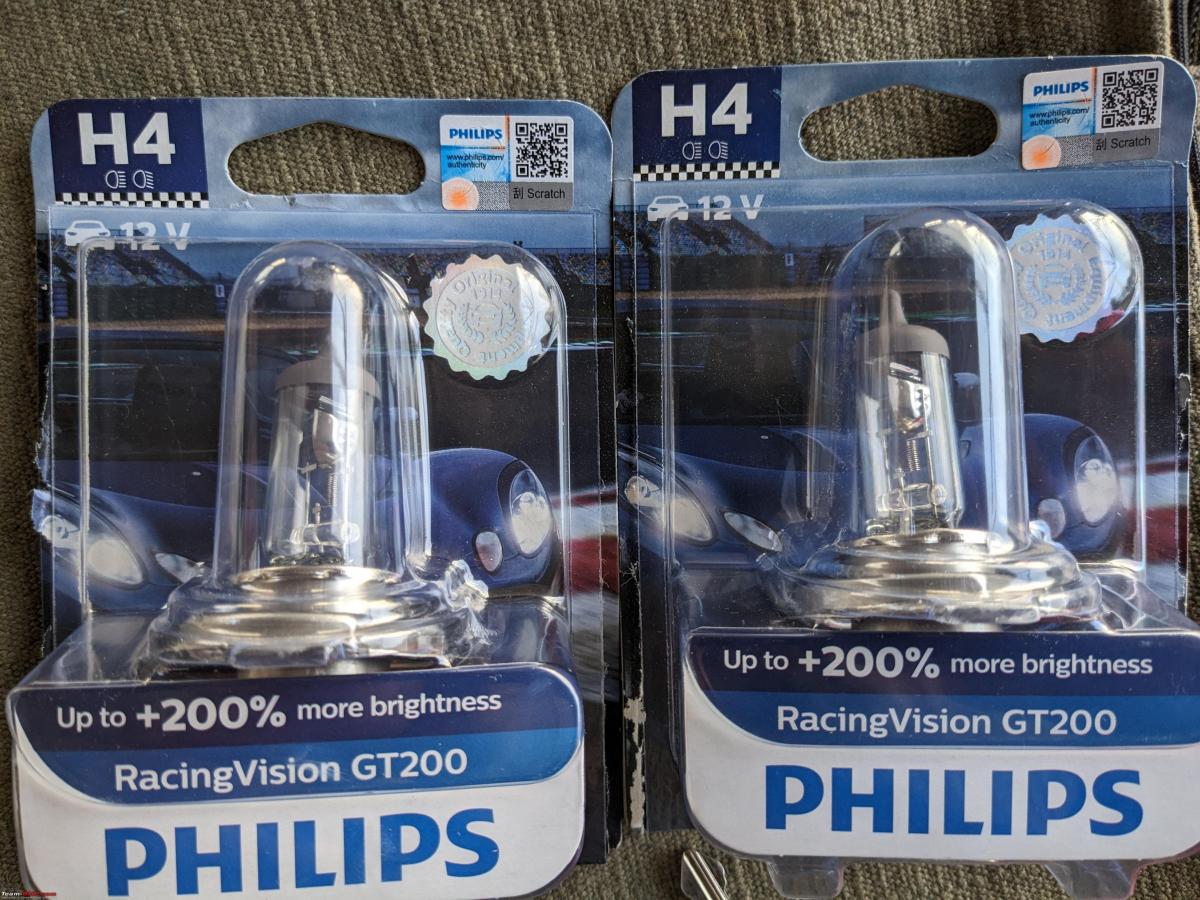
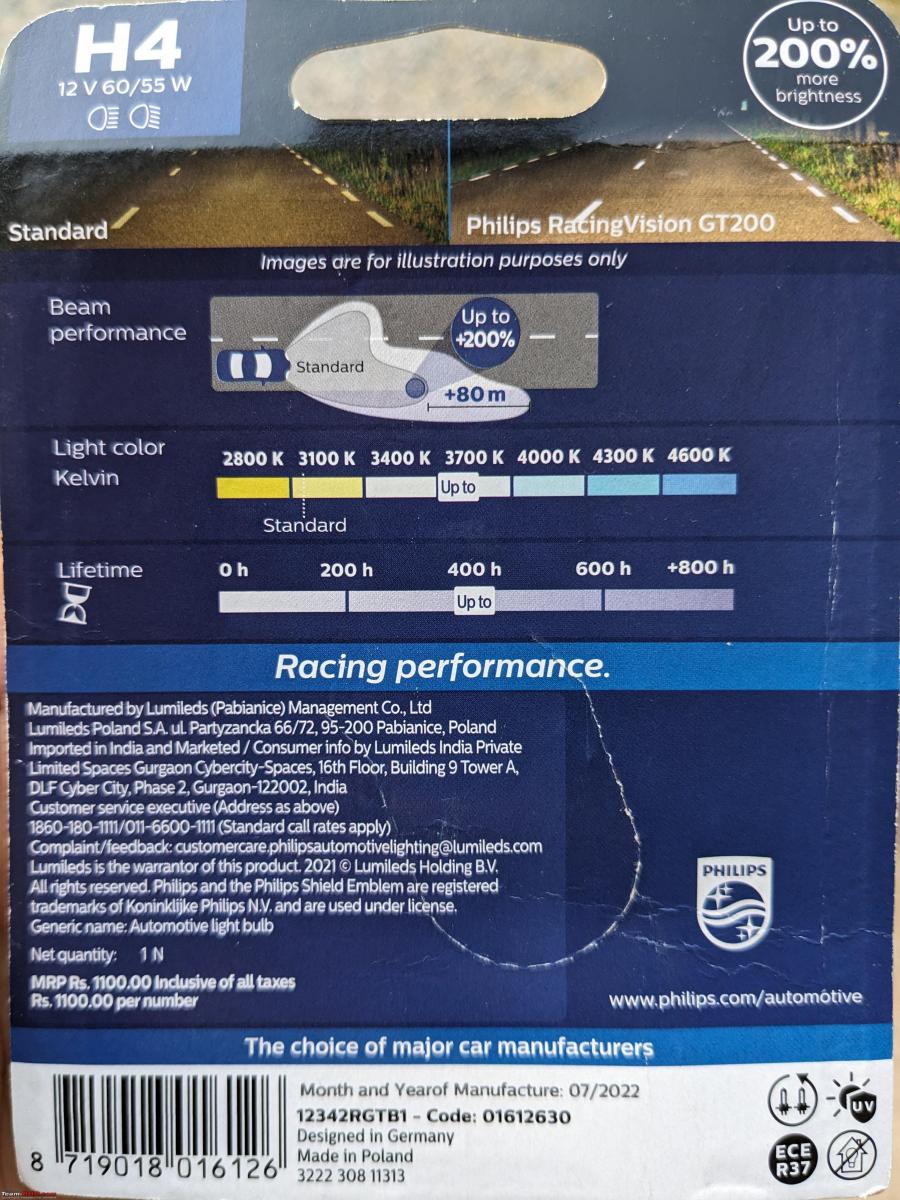
Now, let's talk fuel economy—an absolute star, averaging between 22 to 23 kmpl over the last thousand kilometers. After the first service, hitting the ARAI-specified 24-25 kmpl? Consider it done. Credit to my sedate driving style, but the S-Presso's ability to stretch a tank of fuel is nothing short of remarkable.
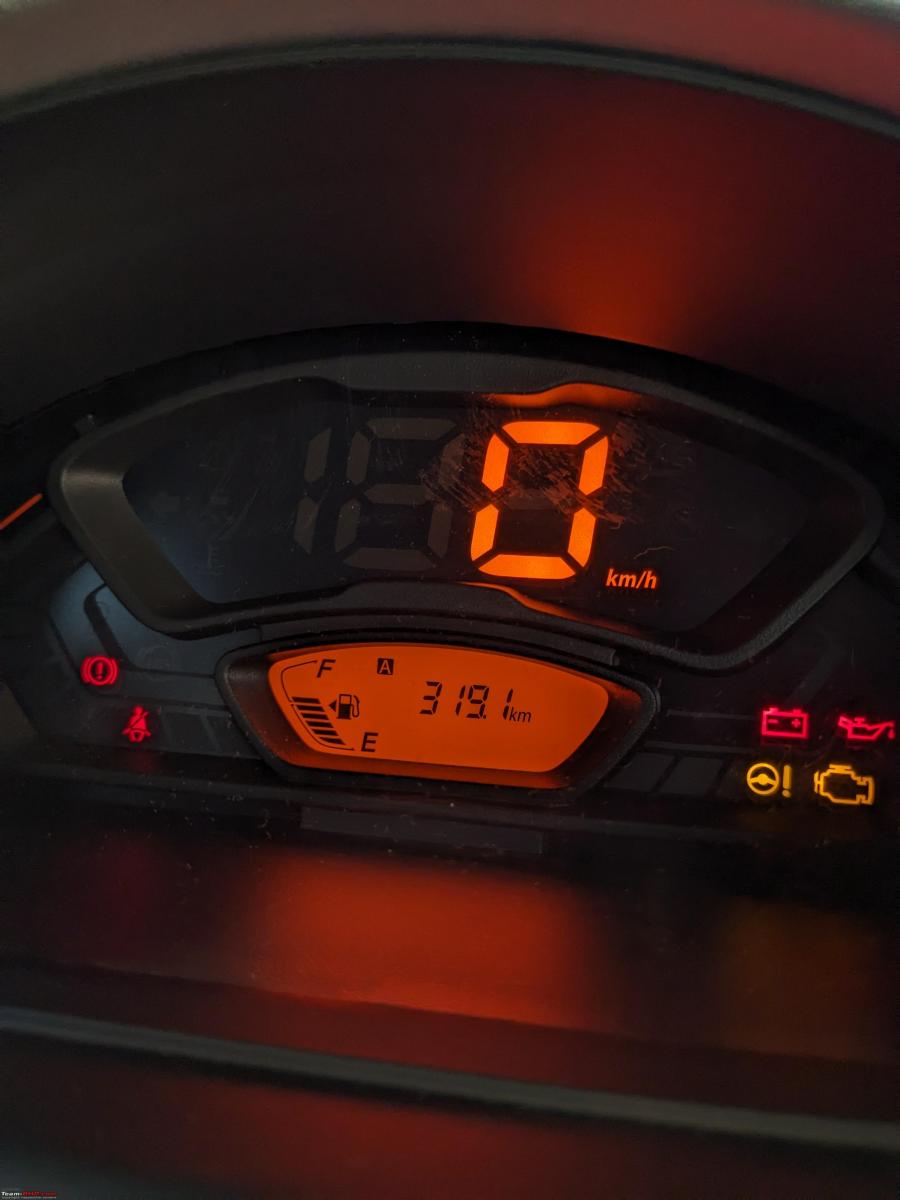
Longest drive yet 300+ km.
Seats, a mixed bag of comfort. I prefer them firm for those marathon drives, and the S-Presso seats held up for a good 200 (4/5 hours) kilometers before needing a break. Standard fare for budget hatchbacks.
Radio tuning is a delight with that elongated antenna. AIR on FM or AM, the S-Presso delivers. Android Auto's temperament depends on your phone model. Pixels and iPhones revel in seamless performance, but glitches may surface with Redmi and Samsung phones.
Here's to a thousand kilometers of quirks, surprises, and a whole lot of S-Presso adventures. A toast to the little car that not only can but excels!
Check out BHPian comments for more insights and information.
- Tags:
- Indian
- Maruti S-Presso
- micro SUV
- Petrol
News
8700km up on my Innova Hycross Hybrid: Rat attack & other updates
The rats managed to tear the AC filter into two parts, split the Plastic Mesh Jali in half, and clog the AC compressor.
BHPian woodstock3001 recently shared this with other enthusiasts.
8700 km update:
Alright, the saga continues. Just a week before my planned trip to Manali, started noticing loud noise in the cabin while fan at high speed. At low fan speed, there was no such noise.
Worried about potential issues, I promptly took my Hycross to the service center.
Unfortunately, my fears were justified – it turned out to be a rat's playground. They managed to tear the AC filter into two parts, split the Plastic Mesh Jali in half, and clog the AC compressor. Fortunately, there was no wire cut. According to Galaxy Toyota, the recommended actions are:
- Replace the AC filter.
- Replace the Plastic Jali with a Steel Jali to prevent future damage.
- Apply rat repellent spray in the engine compartment.
The estimated expense is around 15k. If I opt out of installing the Steel Jali, the cost would be approximately 6k. (15k includes labor charge of 7k just for installing Steel Jali). I've requested a discount and will share the final amount later.
I've given them the green light for the installation of the steel mesh Jali, and the car is expected to be back in 2-3 days. It's disheartening, but essential maintenance is a priority.
Just last week, the ORVM indicator got damaged, so I'll be replacing that as well. Though 2nd service is due in another 1500 KMS, it will be addressed post the Manali excursion.
Stay tuned for the next update with the final bill amount once the car returns.
Check out BHPian comments for more insights and information.
News
Got a Grand Vitara mild hybrid: Booking, delivery & initial impressions
I considered the Honda Elevate as it got launched around the time when I started looking for a new car.
BHPian Gedaliah recently shared this with other enthusiasts.
This write up is to provide information and updates to the esteemed members of this forum on my experience with the booking, delivery and maintenance of a Grand Vitara Mild Hybrid (Manual) edition.
Prologue:
Coming from a middle-class background, a car sometimes felt not really a necessity. However, growing up during the Knight Rider, Street Hawk era, Cars and Bikes were always a part of our childhood fantasies. My childhood car experiences were in the usual Ambassador, Maruti-800 progressing to the Maruti 1000, Zen, Esteem and a rare journey here and there in the Omni. I believe most middle-class population in that era would have experienced the same. We personally owned an Ambassador, 800 and an Esteem (over varying time-periods). These were usually for long distance travels, vacation tours and some weekend trips. For our day-to-day travel and luggage carrying purposes we had the good old Mahindra Jeep. I remember gawking at the rarely visible imported cars such as Toyota Celica, Toyota Corona, Toyota Corolla, Toyota Estima and a rare Honda Civic or Accord as I grew up and travelled to few cities for higher education.
First Car:
Once I found a job, the thoughts of buying a car somehow started. It was not a necessity that time. However, once the colleagues started talking about the new car launches the materialistic instinct pushed me into thinking about buying one. So, it was the already famous and reliable Alto-800 that was bought in 2006. It was super reliable car with the gem of an engine. The maintenance costs never crossed 5-6000 per year during the entire 11 years that I kept it. The running too was not much averaging about 6000 KM per year. The point to note is that I was never stranded anywhere with it other than few punctures that I faced. It served me well and I have only fond memories about it.
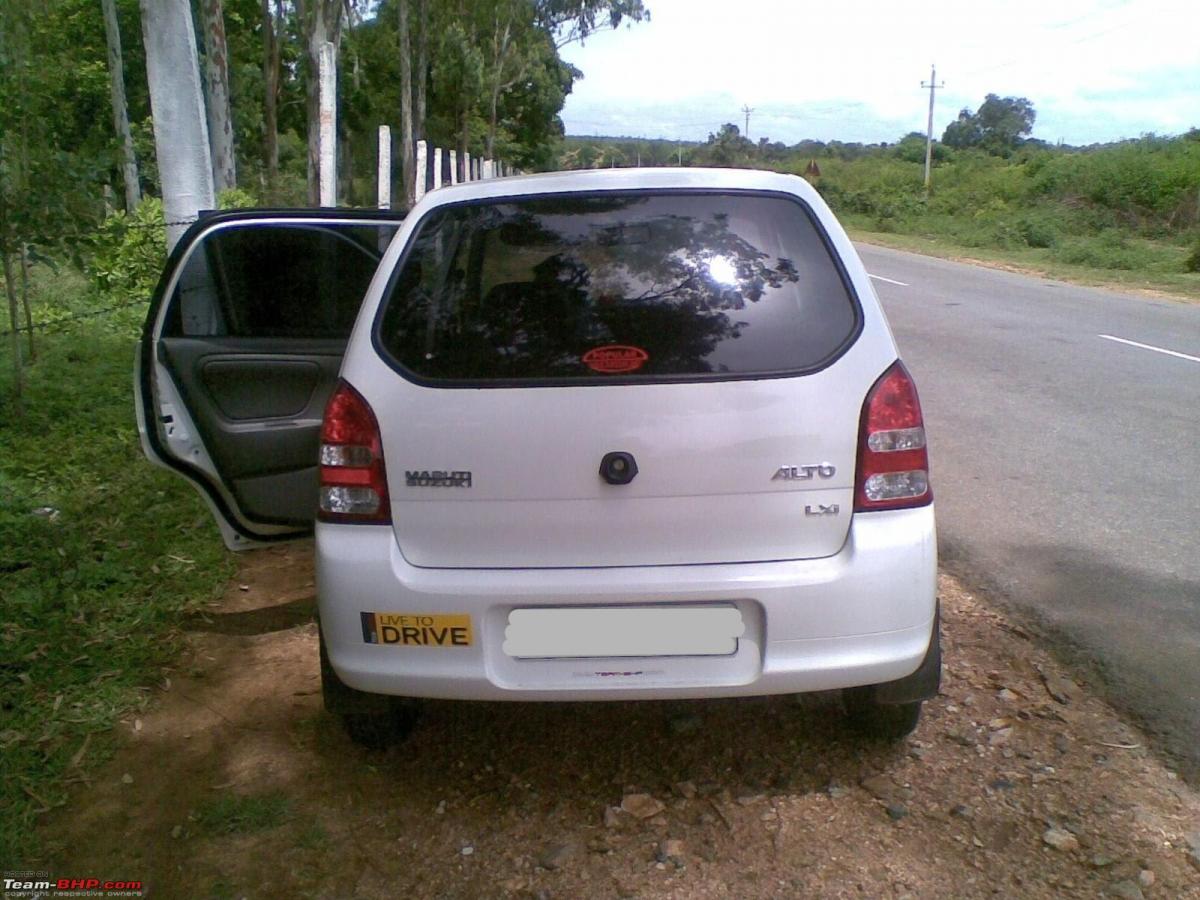
Second Car:
Even though the Alto did not show any signs of aging, and the paintwork never yellowed due to the constant pampering, the itch to buy a new card started in 2017. As a loyal Maruti person, I did not even look at the other brands. So, the Baleno it was. Very enthusiastically went to the Popular Nexa, Kozhikode and there was this premium feel all about. The vehicle too felt premium at that time compared to the other Maruti's we had experienced till then. The sales team agreed to exchange my Alto and quoted some low figure. Anyway, after some bargaining, the price offered came to a reasonable amount and the car was handed over to the dealer. The amount was accepted as the initial payment towards the Baleno. Now the waiting game started. Initially they had promised delivery in three months. Patiently waited or three months not even calling them once in between. After three months went to the dealership and the sales team started their smug behavior. Baleno was flying off the shelves at that time. They requested to wait for another month and I agreed. This happened once more and I was fed up with their attitude. I took the exchange value of my previous vehicle from them and opted for a Ford Ecosport.

The Ecosport is one of the best driver's cars I have ever driven. It is really not that great for the passengers. The back seat comfort is not that great maybe due to the hard suspension setup. However, the steering, the engine, ground clearance, body strength and overall quality were just a level above its competition at that time. If Ford had not left the shores, I would not even have thought about a replacement for it. As the second-hand market value started moving downhill, I had only two options either to keep it till it merges with nature or to sell it and go for a new car.
So, the question was whether to go for a new one or to get a used car. Unfortunately, the used car market is seeing very high demand and the prices are staying high for reliable models. I did look at some used Creta, Innova, Brezza and even Fortuner. The decision making thought process was really not that clear that time. So, you see all sort of vehicles went through the shortlisting process. Later, I sat down and thought what I really need. I loved Diesel in my EcoSport. The torque and fuel economy it provides is just too good. However, the government policies are not really clear regarding the future of Diesel. I am of the opinion that Diesel cannot be completely done away with at least for couple more decades. Moving goods via electric trucks in mountainous areas does not seem to be feasible right now. Therefore, Diesel slowly moved out of consideration. And petrol it was.
There are a lot of options currently in the Indian market for a small-SUV buyer. However, none of them are really there a 100% with respect to quality, features, engine, reliability and economy.
I considered the Honda Elevate as it got launched around the time when I started looking for a new car. I test drove it. The whole experience with the Honda dealer was fantastic. They brought the car home for test drives multiple times and kept following up. Out of all the cars I test drove, I liked the elevate engine-wise. It is absolutely a breeze to drive, and you do feel the quality of the engine and gearbox. I rejected it just because of sub-standard interiors and the question about Honda's survival in India. I didn't want to end up in a similar situation which I experienced with Ford. I would suggest the Elevate next refresh version to anyone looking for a small SUV. By the next refresh all problems would have been ironed out and you get an absolute gem of a car. That is if you are ok with Honda leaving India anytime.
I was never a fan of Hyundai with their gimmicky interiors. I did look at the Creta and I liked it. The only factors against it were that the lower trims were kind of bare bones and there were absolutely no bargaining margin and no free accessories. Compared to the lower trims of other cars, Creta had almost nothing. So, Hyundai was out.
Next was Kia Carens and Seltos. They are similar to Hyundai in terms of the interior pricing and trims. I did not opt for one due to the fact that the nearest service center was a 100KM away. I did not take a test drive of the Kia cars.
It was then that the Brezza, Grand Vitara options were looked at. Grand Vitara made more sense as it is a newer model available via Nexa. Also, there is bit more leg room and a general feeling of better ambiance. I am not sure about part sharing between the two. Friends and family gave the go ahead and it was time to book the car.
Back to Maruti for a second innings:
The Grand Vitara:
Variant : Grand Vitara Delta Manual Mild Hybrid
Booking, PDI Experience:
My booking was done via Popular Vehicles, Kozhikode. The booking experience was smooth unlike the earlier Baleno booking fiasco. This time I was given almost daily updates, pictures, receipts without me having to follow-up with the sales team. The accessories team also didn't push me much to opt for the Nexa accessories. At that time there were no cash discounts available due to the high demand for Grand Vitara. I was allotted a vehicle which was in transit on the condition that it would be accepted only after a PDI. I was allowed a PDI for which they brought the car to the dealer building. They were considerate that the rains had made the yard muddy and against their initial request to visit the yard, the car was brought to the dealership building. They also performed a wash before the PDI. I made a selection of couple of accessories to be fitted before delivery. The accessories selected were primarily the Window rain visors, side step, headlamp, tail lamp garnishes and door molding. I did not opt for the TPMS, vacuum cleaner and the air purifier.
Delivery Experience:
Since my home is around 100 KM from the dealership, I requested them to home deliver. They accepted the request without any fuss. The delivery was given on time without any unnecessary delays.
Dealer Feedback:
Overall, for someone looking for a Nexa dealer in Kozhikode, I would recommend Popular. The sales team is professional, and I didn't see any malpractices performed.
Post-Delivery First Week:
I was little apprehensive driving a Petrol car after having consistently driven a Diesel for many years. I was most worried about starting from a complete stop in the steep hilly areas. I knew that the engine didn't have enough grunt or torque for an easy pull from the slopes. However, the hill-hold-assist function provided with the car helps a lot. This is not much advertised by Suzuki and should have been given prominence as it is a real help.
I tried to keep it slow for the initial 500 or so KMs. It is not as if the car is eager to fly! Overtaking have to be planned a little and going down to at least 3rd gear is required in most circumstances. It does not provide complete confidence in overtaking maneuvers.
The lack of torque and the lethargic engine are the only negatives I felt in the first week and of course for the rest of my ownership. I also have to highlight that there were no squeaks or niggles during the first week.
Second Week and on:
This is a car for sedate drivers. As long as you drive below 70 KMs, the car is obedient to throttle input and you get instant acceleration. However, post 70, reaching 80 Kmph is a small task in itself. And above 80 is almost like kicking the horse's sides and whipping it. It might be the terrain I drive that is contributing to some of these experiences. Still no squeaks and no niggles. The fuel economy is hovering around 16 and I guess it would stay that way.
I had not opted for PPF, ceramic, graphene and not even a Teflon coat. The first things I did on getting the car was applying a coat of Nanolex nanoone and later a coat of GTechniq C2V3 liquid crystal. The water beading is perfect and lasting and no micro-scratches yet. I would advise owners who do not want to spend a lot on cermaic etc.. to go the DIY route by investing in some good microfiber clothes and decent hybrid waxes. Applying coats once in 3 months would surely keep your paint from getting faded.
The car is a bit tough to maintain. The reason being so many nooks and corners where water gets retained. This accumulated water plus dust might lead to corrosion in the longer term. I would suggest owners to keep an eye on this specifically in the back door below the glass area and around the LED setup.
First Free Service:
I completed the first free service when the vehicle had run around 800 KM. There were no issues to report except the chrome headlight garnish had slightly come off. I requested the SA to change the oil and he was apprehensive about it. The SA wanted to get advice and approval from Suzuki Engineer before doing oil change. The engineer did approve and the oil change was done. I was not charged any sort of labor. The overall bill came to 1755 Rs. I did make sure that they refilled with 0w16 oil. I opted not to get the car washed at the dealership when I saw the huge line of cars waiting to get washed.
Overall I am happy with the service at Popular and the only grouch I have is that the SA tried to get my sign on the feedback form without getting me to fill in my feedback. I think it is the usual tricks you find at any service center.
Vehicle Feedback Summary:
Some of the detail mentioned in this section might repeat in likes/dislikes section. Sorry for that.
Alternatives considered - Creta, Seltos, Carens, Elevate.
On-road price & discounts - 15,13,349 Rs. after a cash discount of 7K. Breakdown as follows:
- Ex showroom - 12,10,000
- Insurance - 31,963
- Road Tax - 1,81,700
- Registration Fee - 955
- Fastag - 500
- Accessories - 50,289
- MSR - 885 (Rewards program charge I guess)
- Extended Warranty - 20,567
- CCP - 4,460 (Customer convenience package)
- TCS - 12,030
- Extended warranties & service packages - Opted for the extended warranty 4th and 5th years. The customer convenience pack protecting against water caused issues and fuel quality issues was also taken.
- Engine type & variant - Delta variant with manual transmission
- Safety & related equipment - Two front airbags, ESP, ABS, rear camera and parking sensors (rear).
- Number of kms at the time of writing this review - 1,700
- My usage pattern - Weekly average of around 100 KMs. The drive is primarily in two-lane highways and well-paved village roads with moderate to high traffic in between.
- Wheels & tyres - 17-inch steel wheels come as standard. The tires are 215/60. The tires fill in the wheel well properly and gives a good stance to the car.
- Interior design & quality - The interior is well put together. There is an abundance of hard plastics. No soft touch premium feel here. The color choice is not that great for me personally. The mix of black and burgundy does not look good. However, when you consider the interiors overall it is ok.
- Driving position, ergonomics, controls & MID - It is easy to find a comfortable driving position due to seat height adjustment, seat fore-aft adjustment and the steering reach and rake adjustments available in this variant. The MID provided is the old school analogue type. However, it does provide all the required information in a legible and clear manner. The only grouch regarding the MID is the control stalks that jut out from the MID and definitely from couple of decades ago.
- Visibility & size of mirrors - The overall visibility is not bad. However, the A-pillar is intrusive and creates blind-spots. One should be very careful in turns. The A-pillar can cause you to miss a small vehicle or a pedestrian.
- Air conditioner cooling & effectiveness - This variant comes with ACC. No complaints about the cooling and the ACC functionality. It is a very user-friendly module. The rear AC vents also provides a decent amount of air throw. The cabin gets cooled in no time.
- Audio system & sound quality - The Delta variant comes with the 7 inch screen. Touch functionality is provided and the system is very intuitive to use. Apple CarPlay works flawlessly and map integration is awesome. The sound quality from the inbuilt speakers is above average but nothing to write home about.
- Interior storage, practicality & boot space - The bottle holders are one size too small and cannot hold one litre bottles. You will have to use half litre bottles all around. The glove box is of decent size and the under-armrest storage is also of decent capacity.
- Engine performance & driveability - The mild-hybrid 1.5 litre engine option does not provide outright performance. It is for practical everyday usage and you cannot win any races with it. The engine is ideal for city driving. In the highways it shows its weakness. The performance starts going downhill post 70 Kmph and above 80 it is a struggle.
- Gearshift & clutch - This time Suzuki has given a sure-slotting gearbox. The clutch is light and easy to use. Once is a while the reverse gear refuses to slot and you need to move to a different gear and try again to slot reverse properly.
- Overall NVH levels - It is a super-silent cabin with very low wind noise and engine noise at below 70 Kmph. Above 70, the engine noise does creep in. All who travelled with me noted the silent cabin.
Fuel efficiency:
- City - 9-12 Kmpl
- Highway - 16-17 Kmpl
Suspension & ride quality - The suspension is well tuned and this contributes to great ride quality. You dont have to slow down for small potholes and humps. Even the bigger crater sized-potholes do not negatively affect the posture of the car.
The turning radius at 5.4 meters is bit on the higher side and taking u-turns in city limits is a huge nuisance. You would be doing multiple forward-reverse maneuvers most of the time to get out of situations. Braking is satisfactory and confidence inspiring. Remember Suzuki provided all disc brakes in this car that too for all variants.
Likes:
- Design - The car has a modern design. There are no quirky or weird body areas. The front looks a bit soft compared to proper SUVs.
- Legroom - Legroom at both front and rear is just great, and I think even 6feet plus folks are not going to complain.
- Tires - Those 17-inch tires eat up the potholes, small humps and undulations. It lends to a very comfortable ride to the passengers. The Apollo tires provided is neither too soft nor too hard. Full marks to Suzuki for providing a full-size spare wheel as well.
- Hill hold assist - There is a 2 second delay before brake release on slopes. This helps in controlling backward roll and hilly area rides are comfortable and tension free.
- Electrically foldable mirrors - While it is not auto-fold/open during stops and starts, there is a button provided in Delta variant using which you can fold, open the outside rear-view mirrors.
- Paint quality - Unlike some earlier models like Swift where the paint quality was pathetic to say the least, this time it looks like Suzuki got it right. Though there is slight orange peel effect, the overall paint quality seems to be hard and lustrous.
- Seats - The seats are very comfortable and have adequate bolstering provided. They might not be that great for very heavily built people though.
- Disc brakes - All variants of the GV gets disc brakes all around. It adds to the looks for sure if an allow wheel is used.
Dislikes:
- Headlights - The Delta variant that I have is installed with the Halogen projector version and not the LED. Unfortunately, this is one of the worst headlamp setups that I have experienced. You can equate the light throw to the Ambassador, Premier era. It is so bad that driving in utter darkness is risky and dangerous. You might miss a parked vehicle or a human walking on the kerb.
- Headroom - Due to the design of the car, headroom seems to be lacking. Taller folks might find their head rubbing against the roofline fabric.
- Boot space - The designers again seem to have missed an opportunity to design the car with proper boot. The external dimensions do not translate into proper boot space internally. A design flaw I believe.
- Gear ratios - I believe that this 1.5 engine should have been mated to a 6-speed transmission. For plain-dwellers, a 6-speed might make sense.
- Body design - To make the car appear smart, a lot of nooks and corners have been introduced. These places retain water and dust. It is a pain to clean and might lead to corrosion later on.
- Horn - It is the typical Suzuki horn that is simply ignored by most in traffic-dense scenarios.
- Chrome usage - The car is bit over-chromed at the front. Even though it does not look tacky, it is not to my taste.
Am I happy with the car: Yes
Would I recommend the car to a fellow BHPian: Yes
As many reviewers suggested, the car is a typical Suzuki which would tick most of the boxes and never all the boxes. It does not give any sort of premium feel. But, being a Suzuki in India, you are assured of somewhat reasonable service, parts availability, cheaper parts, spread of service centers, good reliability, somewhat good fuel economy and a good resale value when you decide to part with it.
Some pics:
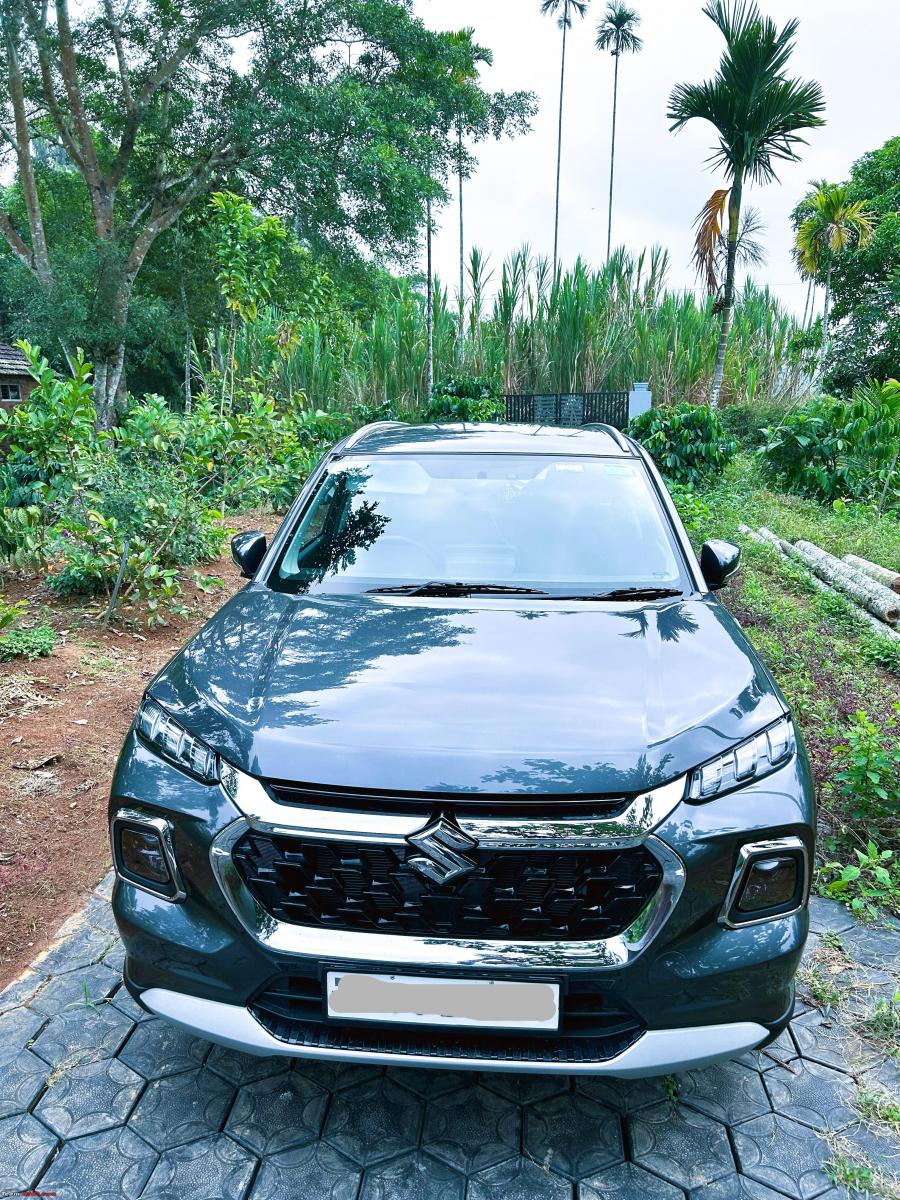
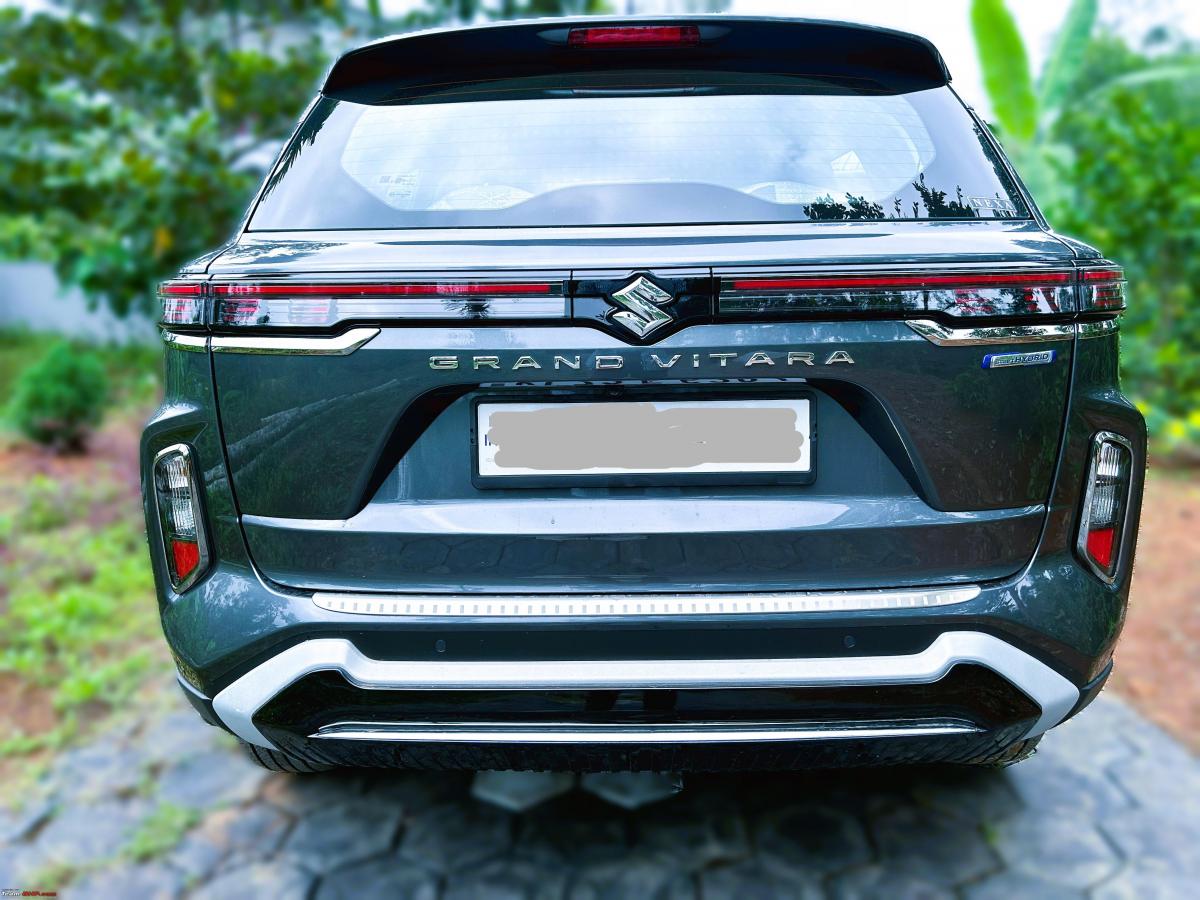
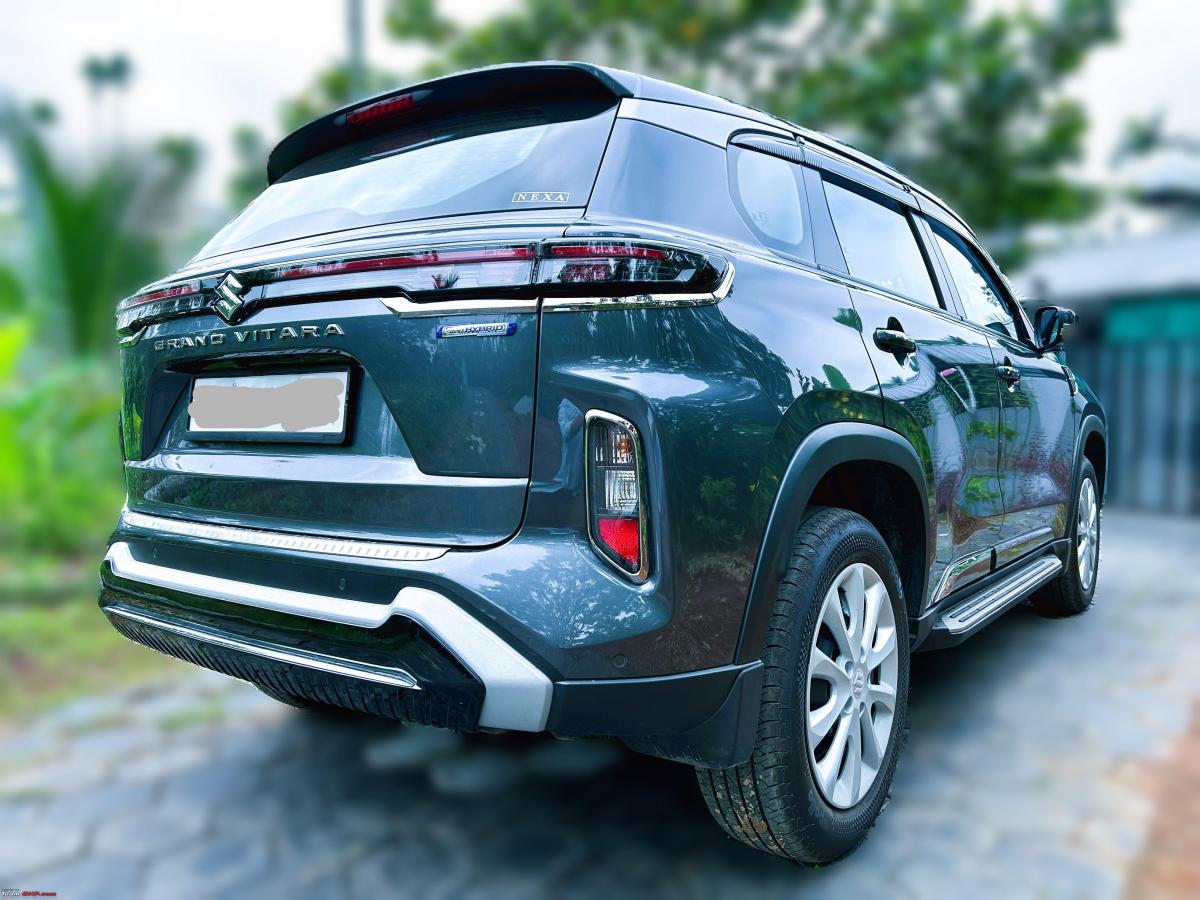

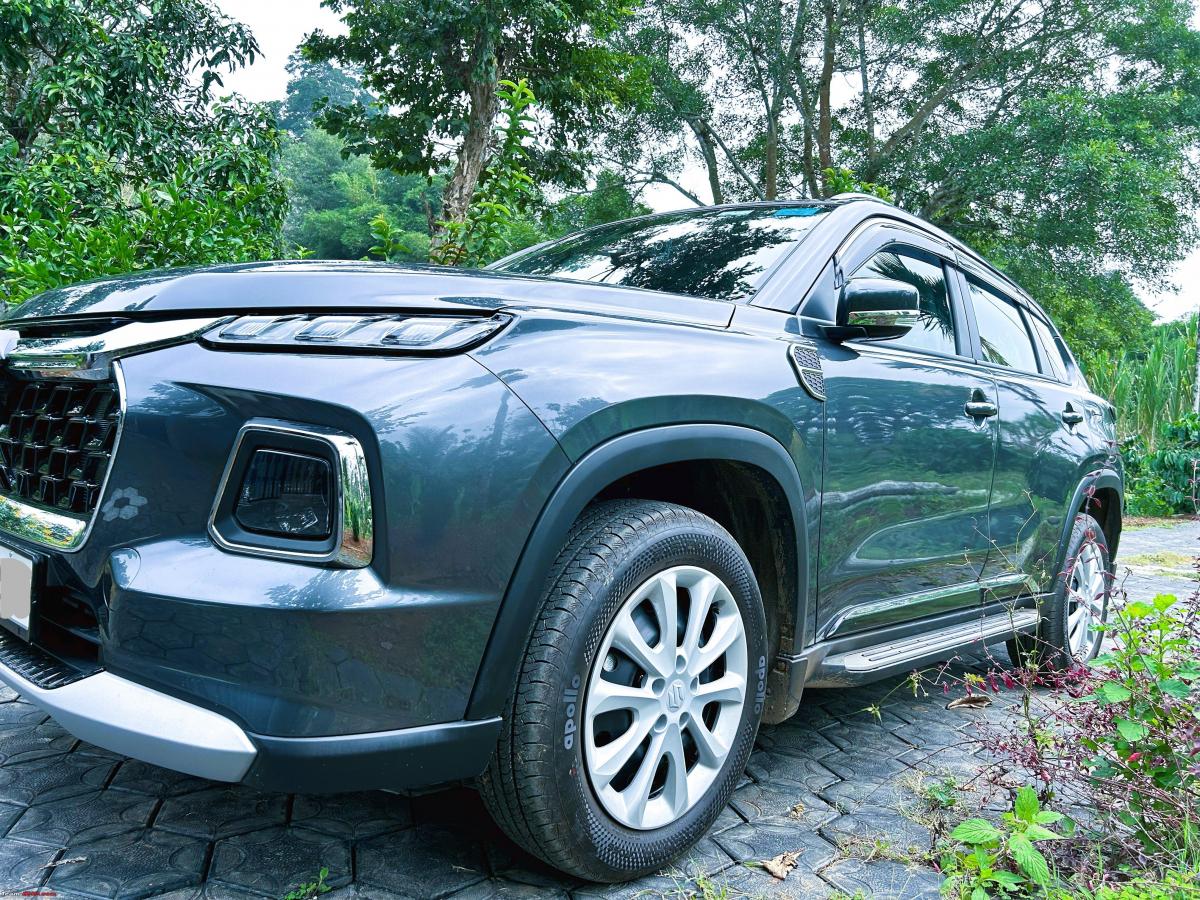
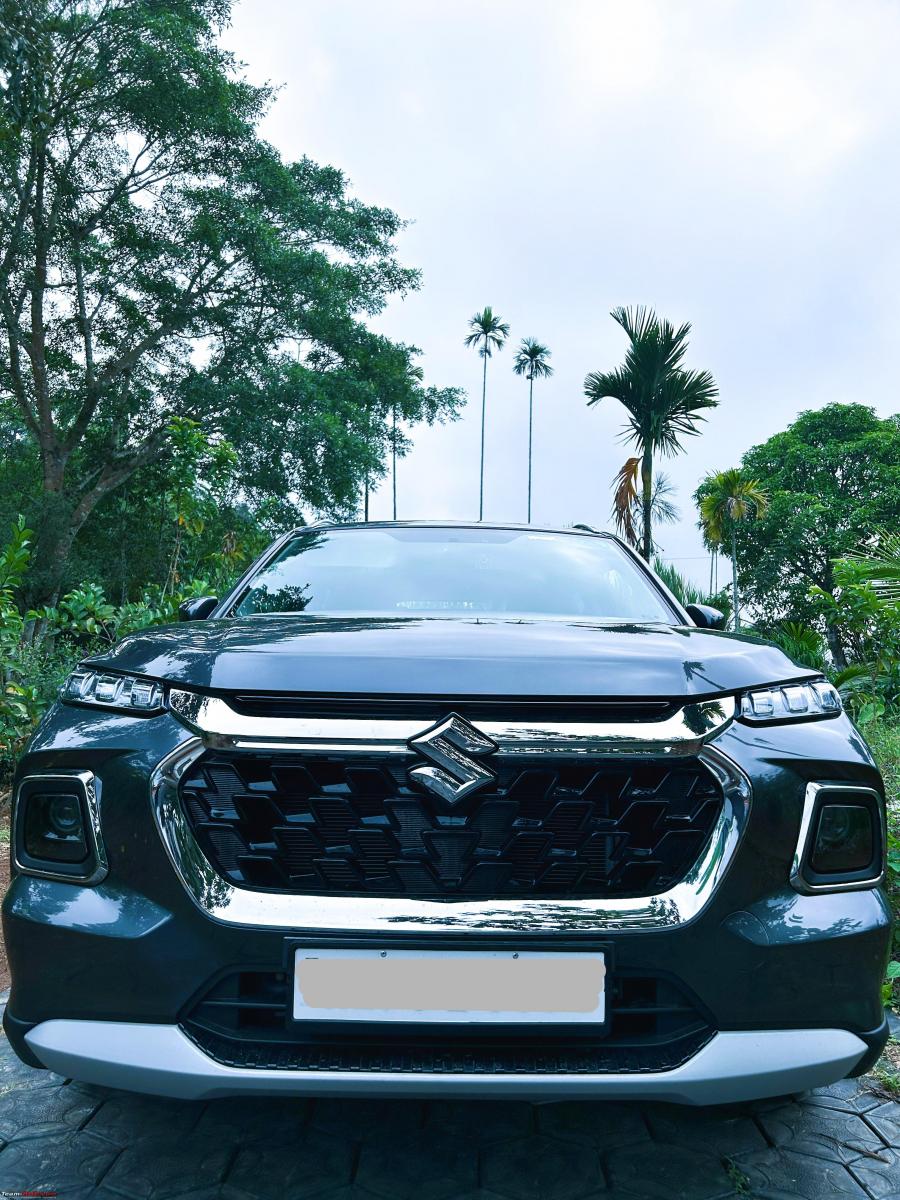
Check out BHPian comments for more insights and information.
Pages




